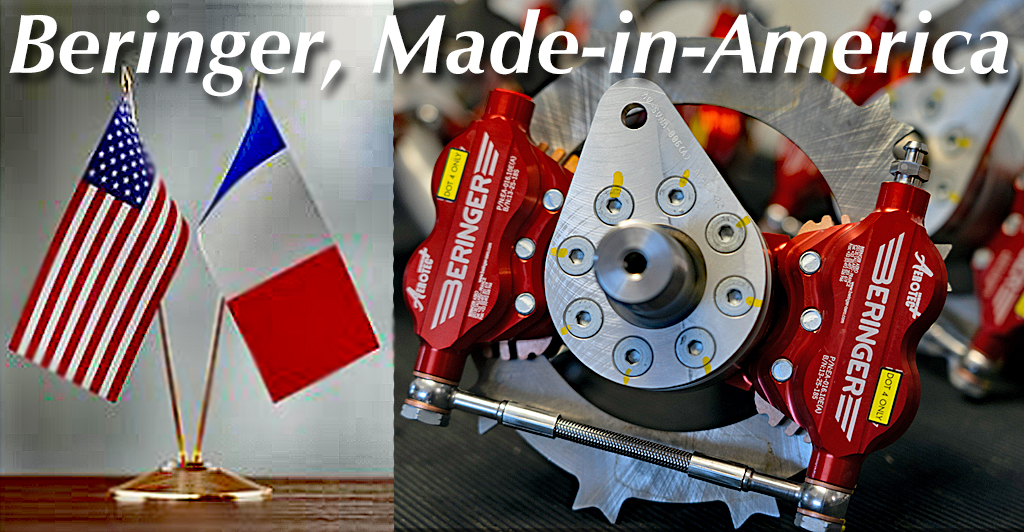
You’ve seen them with their distinctive bright colors and finely-finished hardware. Almost every pilot has. First, they took a big share of the LSA and Sport Pilot kit market. Then they expanded into GA aircraft. Now, welcome a whole new concept for Beringer Aero USA. This story is not simply about a popular French aviation brand selling products in America. Now, they are opening a U.S. production facility — and you could be part of it! After steadily building loyal Yankee customers Beringer knows the USA is a major market. They also understand Americans like buying from USA companies. In 2025, we add the wrinkle of Tariff Wars, making a long-term plan look truly inspired. Colorful Future “Beringer Aero USA is excited to share multiple updates about our company’s remarkable journey and recent developments,” wrote Beringer CEO Claire Beringer. Claire also noted 2025 marks her company’s 40th anniversary.


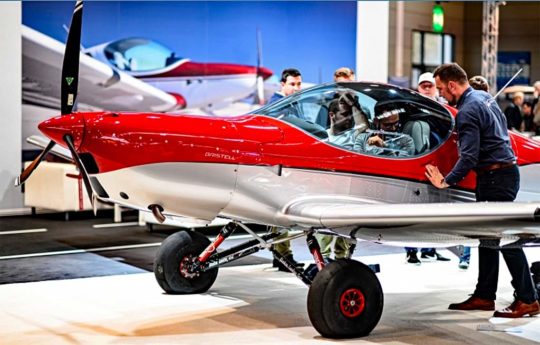
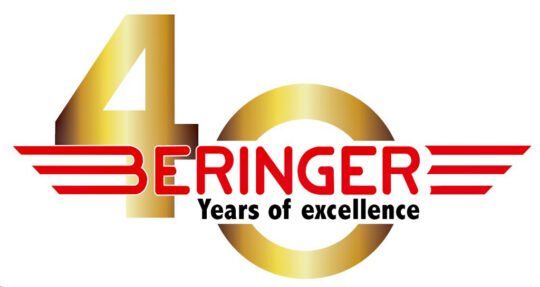 Claire also noted 2025 marks her company's 40th anniversary. "We are profoundly grateful to our customers, partners, and friends who have supported us throughout these decades. Our commitment to innovation and quality in the aircraft wheel and brake industry remains unwavering."
Claire also noted 2025 marks her company's 40th anniversary. "We are profoundly grateful to our customers, partners, and friends who have supported us throughout these decades. Our commitment to innovation and quality in the aircraft wheel and brake industry remains unwavering."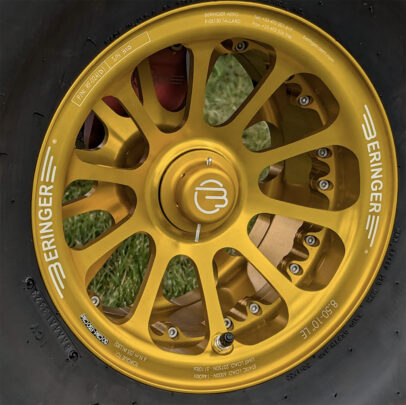
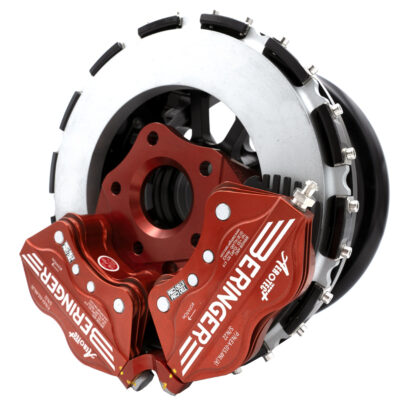 The Greenville, SC facility will enable Beringer to dramatically improve their response times and provide in-country service capabilities. "By bringing production closer to our U.S. customers, we're not just expanding our manufacturing footprint but also investing directly in the local community," Claire stated. She and COO Trevor Burnette expressed keen enthusiasm about their strategic move.
The Greenville, SC facility will enable Beringer to dramatically improve their response times and provide in-country service capabilities. "By bringing production closer to our U.S. customers, we're not just expanding our manufacturing footprint but also investing directly in the local community," Claire stated. She and COO Trevor Burnette expressed keen enthusiasm about their strategic move.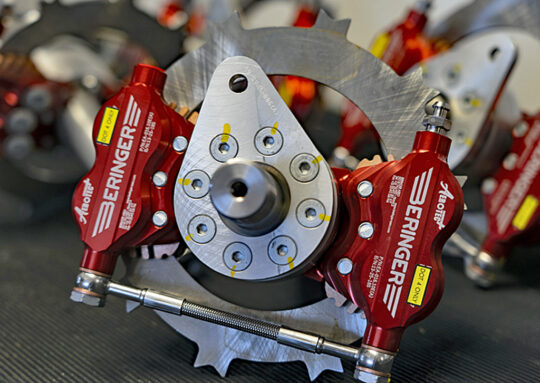 Beringer's current product lineup includes an extensive range of visual documentation, featuring detailed assembly pictures and comprehensive views of their new brake pad technologies.
Beringer's current product lineup includes an extensive range of visual documentation, featuring detailed assembly pictures and comprehensive views of their new brake pad technologies.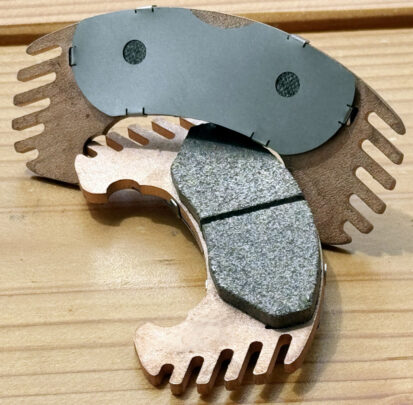 Our recruitment efforts reflect our commitment to building a team that shares our vision of innovation, quality, and customer service. We believe that the right talent can help us continue to push the boundaries of what's possible in aircraft wheel and brake technology.
Our recruitment efforts reflect our commitment to building a team that shares our vision of innovation, quality, and customer service. We believe that the right talent can help us continue to push the boundaries of what's possible in aircraft wheel and brake technology. See a portion of Beringer's extensive product line and hear from CEO Claire Beringer as she talks about their distinctive products for light aircraft.
https://youtu.be/LjRSrHlQXPY?si=AtCCnj-7KvNGPh3I
See a portion of Beringer's extensive product line and hear from CEO Claire Beringer as she talks about their distinctive products for light aircraft.
https://youtu.be/LjRSrHlQXPY?si=AtCCnj-7KvNGPh3I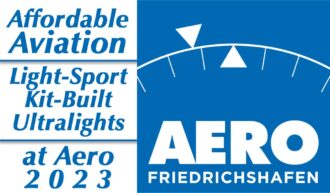
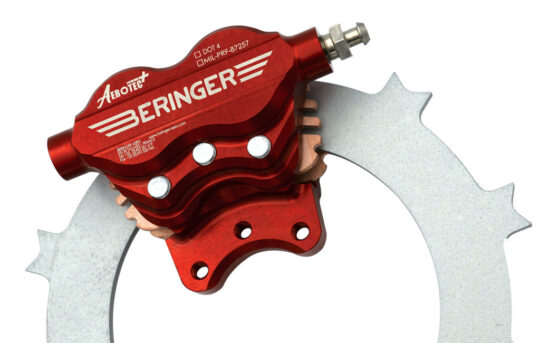 Beringer and its team of 32 employees, has progressively moved up in the ranks of widely-used wheel and brake systems, distinguishing themselves by the safety, reliability, and innovation of its distinctively-colored products.
At Beringer in France, a team of 25 designs, certificates, and manufactures its products while their seven-person USA division "focuses on retail and warehousing for the North-American market, providing customer support and local contact to its customers.”
Beringer and its team of 32 employees, has progressively moved up in the ranks of widely-used wheel and brake systems, distinguishing themselves by the safety, reliability, and innovation of its distinctively-colored products.
At Beringer in France, a team of 25 designs, certificates, and manufactures its products while their seven-person USA division "focuses on retail and warehousing for the North-American market, providing customer support and local contact to its customers.”
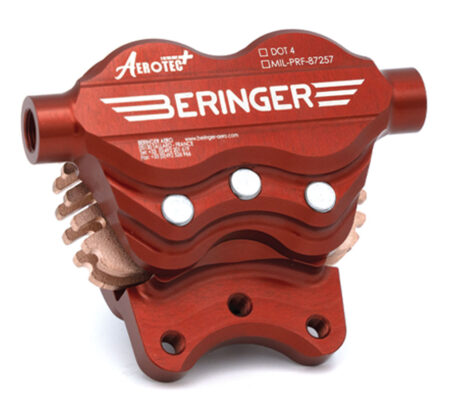 The leaders of Beringer reported, "We did not set out to create 'good enough' wheels and brakes. We sought to create exceptional wheels and brakes, with the goal of providing peace of mind to pilots during the most critical phases of flight." Smart, because while pilots love to go fast, they definitely appreciate a strong set of brakes at the end of the flight.
With its roots in wheel and brake systems, Beringer expanded into landing gear with the Alaskan Landing Gear for Cub-type airframes featuring 12 inches of oleo-pneumatic absorption. Their Shock Wheel system for LSA and ultralights equipped with spring gear gives 8 inches of absorption. Most recently, an innovative three-piece aluminum spring gear called B’Flex was added to the product line.
Established in 2012, Beringer Aero USA relocated from Chicago, Illinois to Greenville, South Carolina. Their newly-acquired facility adjacent to the Greenville Downtown Airport (GMU) is the North American outlet for the French manufacturer operated for 37 years by the Beringer family. Initially specializing in motorcycle wheels, forks, and brakes, the company turned to aviation in 2009. Through almost four decades, Beringer has never stopped innovating.
The leaders of Beringer reported, "We did not set out to create 'good enough' wheels and brakes. We sought to create exceptional wheels and brakes, with the goal of providing peace of mind to pilots during the most critical phases of flight." Smart, because while pilots love to go fast, they definitely appreciate a strong set of brakes at the end of the flight.
With its roots in wheel and brake systems, Beringer expanded into landing gear with the Alaskan Landing Gear for Cub-type airframes featuring 12 inches of oleo-pneumatic absorption. Their Shock Wheel system for LSA and ultralights equipped with spring gear gives 8 inches of absorption. Most recently, an innovative three-piece aluminum spring gear called B’Flex was added to the product line.
Established in 2012, Beringer Aero USA relocated from Chicago, Illinois to Greenville, South Carolina. Their newly-acquired facility adjacent to the Greenville Downtown Airport (GMU) is the North American outlet for the French manufacturer operated for 37 years by the Beringer family. Initially specializing in motorcycle wheels, forks, and brakes, the company turned to aviation in 2009. Through almost four decades, Beringer has never stopped innovating.
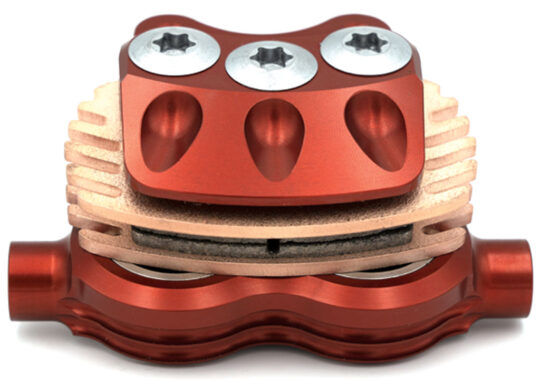 "Representing a culmination of decades of production, testing, and experience, Aerotec+ offers a fundamentally new package designed for safety and increased performance," said Beringer.
Two floating brake pads provide cooling from all sides, therefore lowering operating temperature for reduced pad wear and better caliper protection. Furthermore, the brake pad back plate has cooling fins to increase surface area and is made of a special steel alloy rated for higher temperatures that provides 20% more torque.
Aerotec+'s brake disc has been redesigned with a special steel alloy to increase the coefficient of friction while also handling higher temperatures while the brake caliper has been redesigned to increase rigidity for higher piston loads and incorporates new cooling fins to help dissipate heat. Beringer said Aerotec+'s 20% added torque translates into 15 to 30% greater kinetic energy meaning reduced landing distances.
What goes up must eventually stop and Beringer is determined to slow you down easily.
"Representing a culmination of decades of production, testing, and experience, Aerotec+ offers a fundamentally new package designed for safety and increased performance," said Beringer.
Two floating brake pads provide cooling from all sides, therefore lowering operating temperature for reduced pad wear and better caliper protection. Furthermore, the brake pad back plate has cooling fins to increase surface area and is made of a special steel alloy rated for higher temperatures that provides 20% more torque.
Aerotec+'s brake disc has been redesigned with a special steel alloy to increase the coefficient of friction while also handling higher temperatures while the brake caliper has been redesigned to increase rigidity for higher piston loads and incorporates new cooling fins to help dissipate heat. Beringer said Aerotec+'s 20% added torque translates into 15 to 30% greater kinetic energy meaning reduced landing distances.
What goes up must eventually stop and Beringer is determined to slow you down easily.
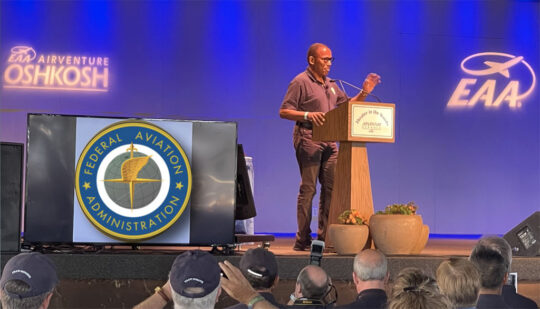
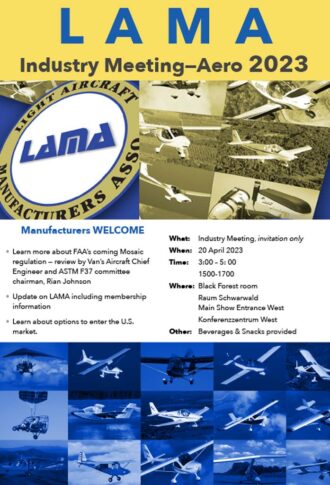

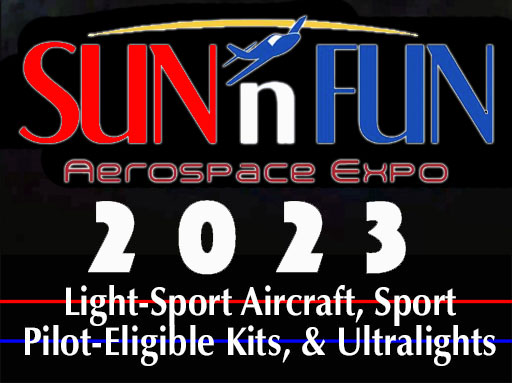 In a splendid professional presentation, Waco Aircraft unveiled their newest vintage-style aircraft. Well, that's close to factual. In truth, Junkers Aircraft is its own company, but as it shares common ownership, it's OK to group these two vintage designs together, partly as they are both 100% built-in-America designs.
In a splendid professional presentation, Waco Aircraft unveiled their newest vintage-style aircraft. Well, that's close to factual. In truth, Junkers Aircraft is its own company, but as it shares common ownership, it's OK to group these two vintage designs together, partly as they are both 100% built-in-America designs.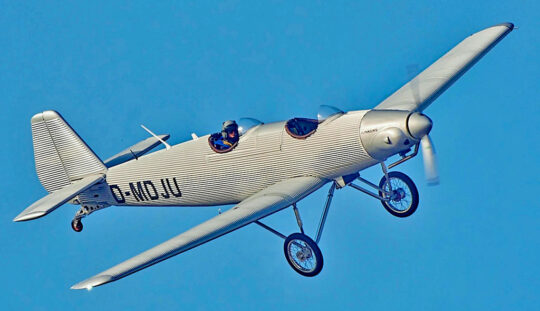 In Battle Creek, Michigan a European businessman, Dieter Morszeck, has invested more than $30 million to create a modern airplane factory capable of producing such complex yet handsome designs as the Waco biplane. For 2023, that facility has a new occupant, Junkers Aircraft. Both are owned by Dieter and this man is serious about aviation.
Mr. Morszeck made his money in the luggage business. His brand, Rimowa, is known widely for its corrugated exterior, leaving an earlier Junkers aircraft built similarly to be dubbed the "flying suitcase." This is a delicious bit of serendipity because now his former luggage business can be expressed in an airplane… one that draws people's attention wherever it shows up. I observed pilots keen to sit in A50 Junior simply to experience a bit of history.
In Battle Creek, Michigan a European businessman, Dieter Morszeck, has invested more than $30 million to create a modern airplane factory capable of producing such complex yet handsome designs as the Waco biplane. For 2023, that facility has a new occupant, Junkers Aircraft. Both are owned by Dieter and this man is serious about aviation.
Mr. Morszeck made his money in the luggage business. His brand, Rimowa, is known widely for its corrugated exterior, leaving an earlier Junkers aircraft built similarly to be dubbed the "flying suitcase." This is a delicious bit of serendipity because now his former luggage business can be expressed in an airplane… one that draws people's attention wherever it shows up. I observed pilots keen to sit in A50 Junior simply to experience a bit of history.
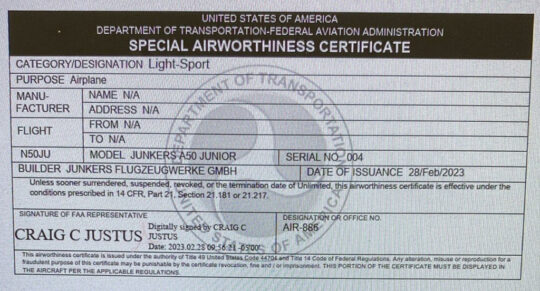 For additional information on A50 Junior, please
For additional information on A50 Junior, please 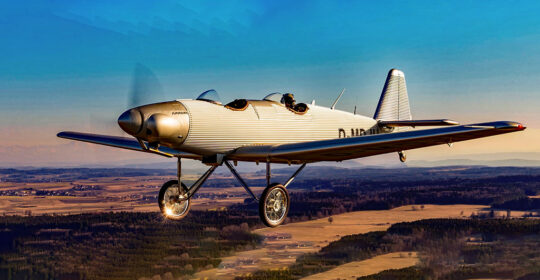 A Swiss team was engaged to create the first example of A50 Junior in the modern age. Now that the prototyping is done and Special LSA approval has been granted from FAA, A50 can enter the U.S. market and its first buyers are already stepping up.
As you might expect from an aircraft of this highly detailed construction, this is not the least costly SLSA on the market. However, for those filled with desire, the first 29 airplanes — a nod to the year of its first introduction in 1929 — will be sold for about $195,000. I predict they won't have too much trouble finding buyers, especially as many LSA are now approaching (or have exceeded) that price.
A Swiss team was engaged to create the first example of A50 Junior in the modern age. Now that the prototyping is done and Special LSA approval has been granted from FAA, A50 can enter the U.S. market and its first buyers are already stepping up.
As you might expect from an aircraft of this highly detailed construction, this is not the least costly SLSA on the market. However, for those filled with desire, the first 29 airplanes — a nod to the year of its first introduction in 1929 — will be sold for about $195,000. I predict they won't have too much trouble finding buyers, especially as many LSA are now approaching (or have exceeded) that price.
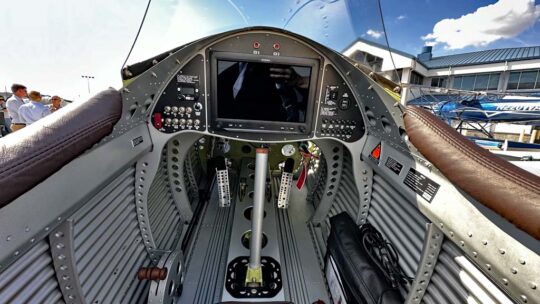 Junkers isn't done. An A52 model with side-by-side seating and retractable gear could enter the market as a Mosaic LSA or mLSA. Dieter and his team are already pondering that move and, again, their U.S. factory is set up and ready to produce.
Junkers isn't done. An A52 model with side-by-side seating and retractable gear could enter the market as a Mosaic LSA or mLSA. Dieter and his team are already pondering that move and, again, their U.S. factory is set up and ready to produce.
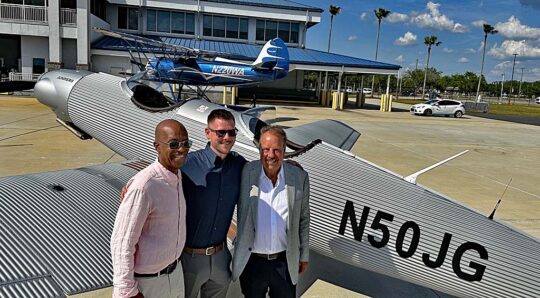
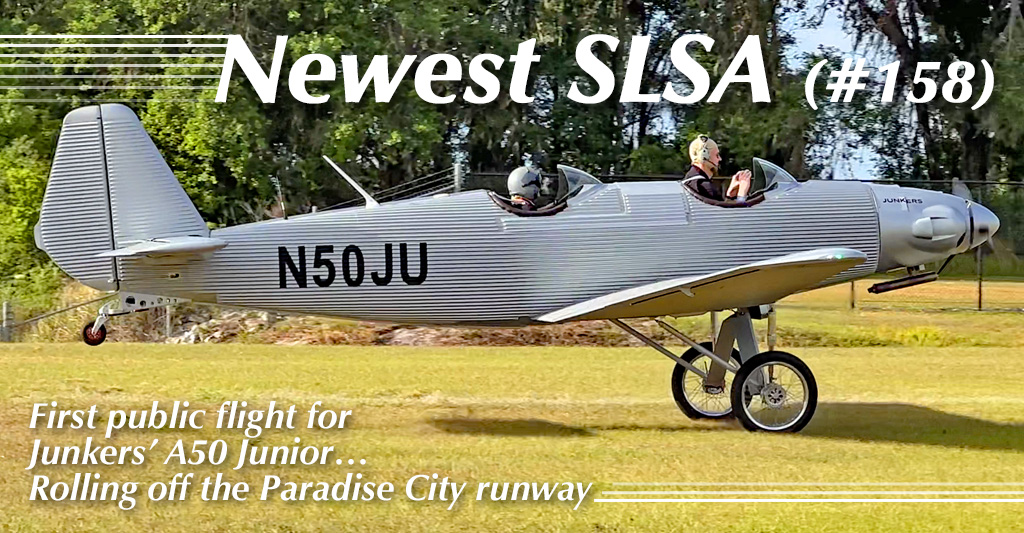
 Rather loudly and persistently I beat the drum about "affordable aircraft," but readers also enjoy learning about other aircraft. I will never write about jets or multimillion-dollar turbines but I will continue to follow any "light" aircraft that meets LSA parameters now or after the Mosaic rule.
In this article I will describe how two aircraft are pursuing conventional certification: Flight Design’s F2-CS23 and Icon’s A5.
Rather loudly and persistently I beat the drum about "affordable aircraft," but readers also enjoy learning about other aircraft. I will never write about jets or multimillion-dollar turbines but I will continue to follow any "light" aircraft that meets LSA parameters now or after the Mosaic rule.
In this article I will describe how two aircraft are pursuing conventional certification: Flight Design’s F2-CS23 and Icon’s A5.
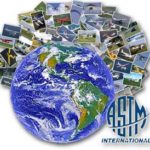 Contrary to common language, LSA are not "certified." Instead a manufacturer declares they meet ASTM standards and FAA "accepts" that declaration. Frequently at first, FAA audited producers in a point-by-point check of their declaration plus verifying that producers use generally-accepted best practices in their manufacturing. Companies with prior approvals may not be required to undergo an audit; it's always FAA's choice.
I've been involved with ASTM for many years and I can attest to these standards being very rigorous. They were welcomed by many countries where they are in active use. Indeed, FAA is using ASTM standards for LSA as a model for a future approval system for Part 23 general aviation aircraft. Nonetheless, a Standard Certificate is required for some countries; LSA have a Special Certificate. So, some companies believe it is in their best interest to obtain the higher level of approval.
Contrary to common language, LSA are not "certified." Instead a manufacturer declares they meet ASTM standards and FAA "accepts" that declaration. Frequently at first, FAA audited producers in a point-by-point check of their declaration plus verifying that producers use generally-accepted best practices in their manufacturing. Companies with prior approvals may not be required to undergo an audit; it's always FAA's choice.
I've been involved with ASTM for many years and I can attest to these standards being very rigorous. They were welcomed by many countries where they are in active use. Indeed, FAA is using ASTM standards for LSA as a model for a future approval system for Part 23 general aviation aircraft. Nonetheless, a Standard Certificate is required for some countries; LSA have a Special Certificate. So, some companies believe it is in their best interest to obtain the higher level of approval.
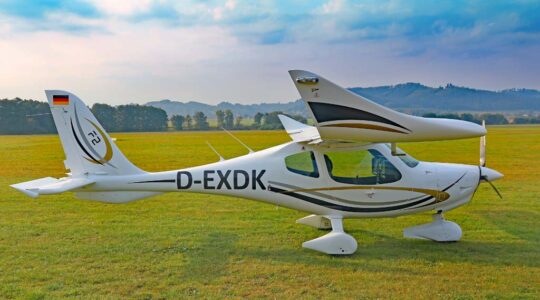 “We couldn’t be happier to see this important step for the F2 program, which ultimately will lead to the F4 four-seat version and the all-electric F2e,” said Matthias Betsch, Head of Flight Design's Design Organization department that created the F-Series and many of its advanced concepts.
"The F2-CS23 is the next step in Flight Design’s ‘Vision Zero’ concept which incorporates all commercially available safety features appropriate for this type of aircraft," the company elaborated. "These features include: a passive stall and spin resistant airframe design; airframe emergency parachute system; Amsafe-brand airbags and inertial reel harnesses; Garmin ESP (electronic stability and envelope protection); a strong occupant-protective enclosure for the pilot and passengers; automatic fuel management; simplified controls such as a combined throttle and brake lever; and a more modern, car-like atmosphere and operation."
“We couldn’t be happier to see this important step for the F2 program, which ultimately will lead to the F4 four-seat version and the all-electric F2e,” said Matthias Betsch, Head of Flight Design's Design Organization department that created the F-Series and many of its advanced concepts.
"The F2-CS23 is the next step in Flight Design’s ‘Vision Zero’ concept which incorporates all commercially available safety features appropriate for this type of aircraft," the company elaborated. "These features include: a passive stall and spin resistant airframe design; airframe emergency parachute system; Amsafe-brand airbags and inertial reel harnesses; Garmin ESP (electronic stability and envelope protection); a strong occupant-protective enclosure for the pilot and passengers; automatic fuel management; simplified controls such as a combined throttle and brake lever; and a more modern, car-like atmosphere and operation."
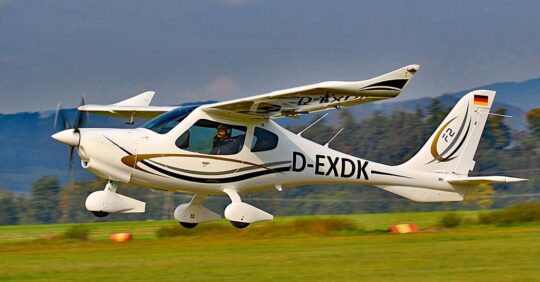
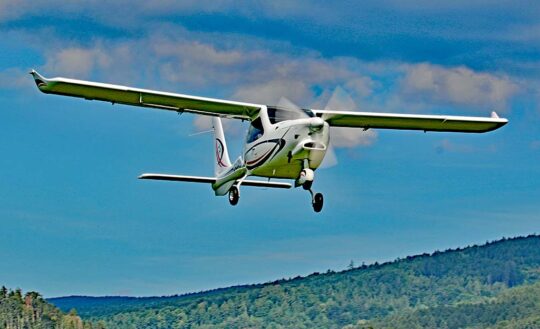 “EASA's CS-23 category is an internationally-recognized certification standard which will allow the new F2-CS23 to be easily accepted in all markets worldwide,” said Dieter Koehler, Project Manager the F2 and F4 projects.
Flight Design sees the F2-CS23 as "an excellent choice for flight schools with its wide and easy-to-enter cockpit, fuel efficiency, unique safety features, and state-of-the-art avionics suite. All new Flight Design aircraft come with carbon compensation up to TBO under Flight Design’s Pro-Climate plan." F2-CS23 follows the company's F2-LSA that began deliveries earlier in 2021.
“EASA's CS-23 category is an internationally-recognized certification standard which will allow the new F2-CS23 to be easily accepted in all markets worldwide,” said Dieter Koehler, Project Manager the F2 and F4 projects.
Flight Design sees the F2-CS23 as "an excellent choice for flight schools with its wide and easy-to-enter cockpit, fuel efficiency, unique safety features, and state-of-the-art avionics suite. All new Flight Design aircraft come with carbon compensation up to TBO under Flight Design’s Pro-Climate plan." F2-CS23 follows the company's F2-LSA that began deliveries earlier in 2021.
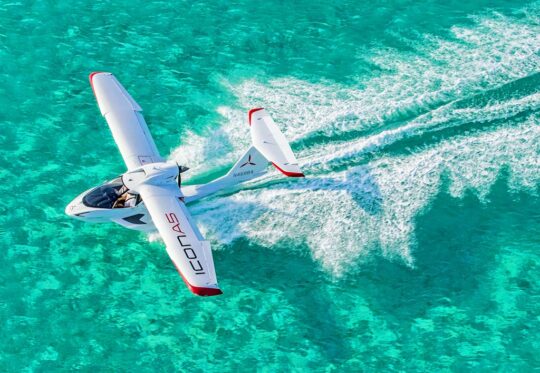 "In countries that do not have a Light-Sport category (Canada and others), the Type Certified version of the
"In countries that do not have a Light-Sport category (Canada and others), the Type Certified version of the 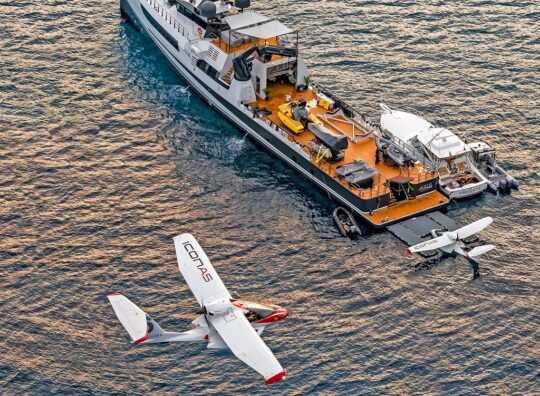 Primary Category certification also has benefits in the U.S., Icon reported. One is that any A&P is authorized to work on it. Because it is not a SLSA, owners will not need to use designated Icon Service Partners, though the company will still encourage them to do so.
Another benefit is international travel, for example, flying your Icon A5 to islands in the Caribbean, or to keep your A5 on a yacht when you are in another country (image). "Light-Sport Aircraft do not receive a Type Certificate," Icon explained, "so typically, special permission is required before you can fly in another country just like if you are flying an Experimental aircraft." Some exceptions exist, notably in the Bahamas, which does allow U.S.-registered LSAs. The Bahamas is further unique among other countries in that they accept FAA's Sport Pilot certificate.
Primary Category certification also has benefits in the U.S., Icon reported. One is that any A&P is authorized to work on it. Because it is not a SLSA, owners will not need to use designated Icon Service Partners, though the company will still encourage them to do so.
Another benefit is international travel, for example, flying your Icon A5 to islands in the Caribbean, or to keep your A5 on a yacht when you are in another country (image). "Light-Sport Aircraft do not receive a Type Certificate," Icon explained, "so typically, special permission is required before you can fly in another country just like if you are flying an Experimental aircraft." Some exceptions exist, notably in the Bahamas, which does allow U.S.-registered LSAs. The Bahamas is further unique among other countries in that they accept FAA's Sport Pilot certificate.
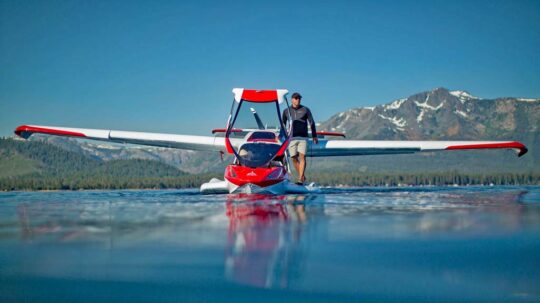 "International expansion has been a critical part of our business plan since day one,” said Jason Huang, President of Icon Aircraft. “People in the U.S. have been able to enjoy adventure flying in the Icon A5 for several years, and we will continue to produce the SLSA version. But now we are excited to introduce the A5 to others around the world. Type Certification is one of the many investments Icon has made to grow our capabilities and improve the A5. We know it will be appreciated by our international deposit holders and sales partners, and we are all very excited for this day to come."
"International expansion has been a critical part of our business plan since day one,” said Jason Huang, President of Icon Aircraft. “People in the U.S. have been able to enjoy adventure flying in the Icon A5 for several years, and we will continue to produce the SLSA version. But now we are excited to introduce the A5 to others around the world. Type Certification is one of the many investments Icon has made to grow our capabilities and improve the A5. We know it will be appreciated by our international deposit holders and sales partners, and we are all very excited for this day to come."
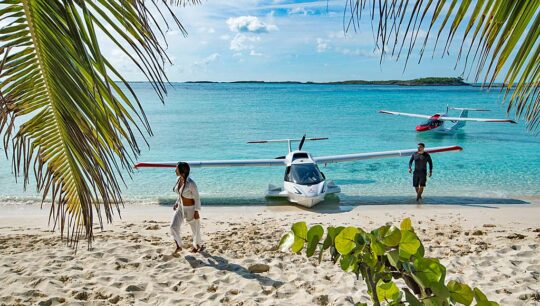 "Note that we will continue to make the SLSA version, as well," assured Huang. This continues the chance for American pilots to fly A5 without the need for an aviation medical, using only their driver's license in lieu of a medical approval.
Why not pursue approval using the coming regulation often referred to as Mosaic?
"Mosaic is an FAA initiative that doesn’t translate globally," stated the company. "Thus, pursuing Primary Category Certification is the action we needed to coincide with our global expansion plans."
"Note that we will continue to make the SLSA version, as well," assured Huang. This continues the chance for American pilots to fly A5 without the need for an aviation medical, using only their driver's license in lieu of a medical approval.
Why not pursue approval using the coming regulation often referred to as Mosaic?
"Mosaic is an FAA initiative that doesn’t translate globally," stated the company. "Thus, pursuing Primary Category Certification is the action we needed to coincide with our global expansion plans."
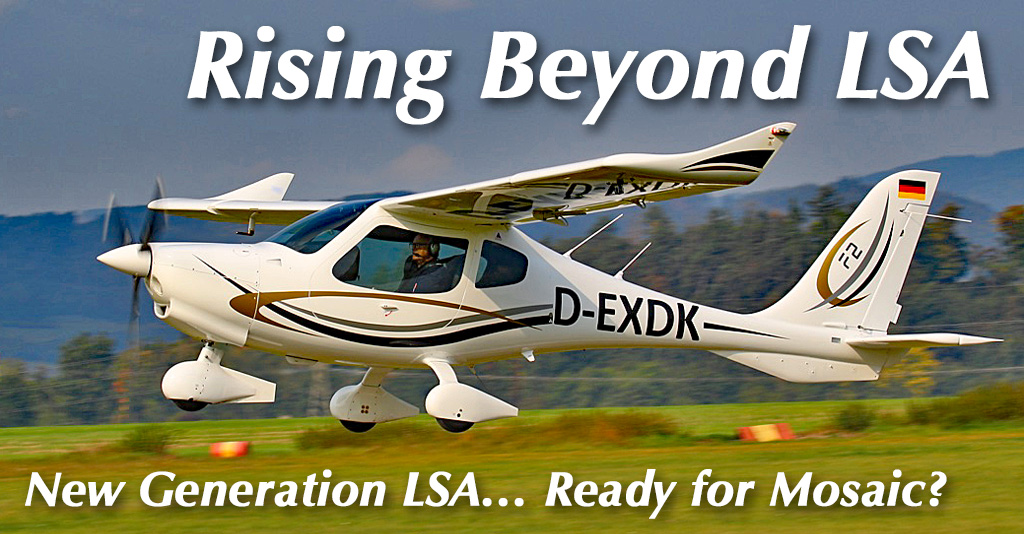
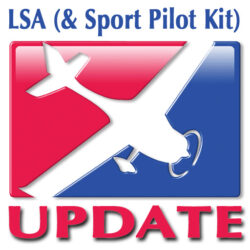 In this edition of “LSA Update,” I'll cover an update about…
1️⃣ Jabiru and their AirVenture activities; 2️⃣ Beringer's new SensAir system that works with your smartphone; 3️⃣ an impressive father-and-daughter partnership forming a new dealer for Seamax; 4️⃣ a preview of the new Dragon powered paraglider single-place quad; and, 5️⃣ competition successes for E-Props and Polini engines.
In this edition of “LSA Update,” I'll cover an update about…
1️⃣ Jabiru and their AirVenture activities; 2️⃣ Beringer's new SensAir system that works with your smartphone; 3️⃣ an impressive father-and-daughter partnership forming a new dealer for Seamax; 4️⃣ a preview of the new Dragon powered paraglider single-place quad; and, 5️⃣ competition successes for E-Props and Polini engines.
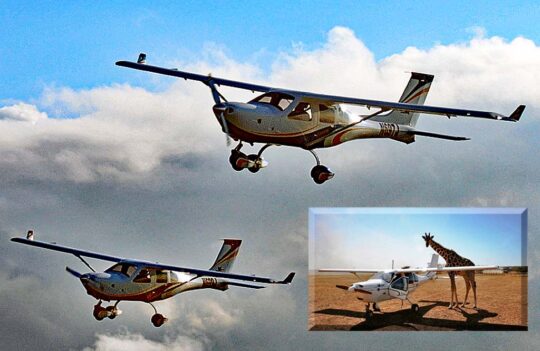 Not only was Jabiru one of the first approved SLSA (#22) but also one of the most prolific with SLSA #22 J250-SP, #23 J170-SP, #40 Calypso SP, #67 J230-SP (redesignated as J230-D in 2013), and #142 J170-D. The "SP models came from an earlier U.S.-based manufacturing arrangement. The "D" denotes the manufacturing now conducted in Australia.
When you are an early entrant you have time to get the details right and flesh out the operation.
Not only was Jabiru one of the first approved SLSA (#22) but also one of the most prolific with SLSA #22 J250-SP, #23 J170-SP, #40 Calypso SP, #67 J230-SP (redesignated as J230-D in 2013), and #142 J170-D. The "SP models came from an earlier U.S.-based manufacturing arrangement. The "D" denotes the manufacturing now conducted in Australia.
When you are an early entrant you have time to get the details right and flesh out the operation.
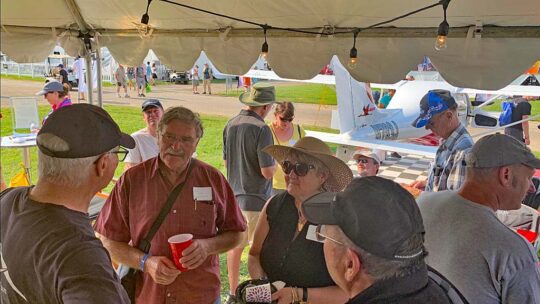 Now in the capable hands of Scott Severen, who runs
Now in the capable hands of Scott Severen, who runs 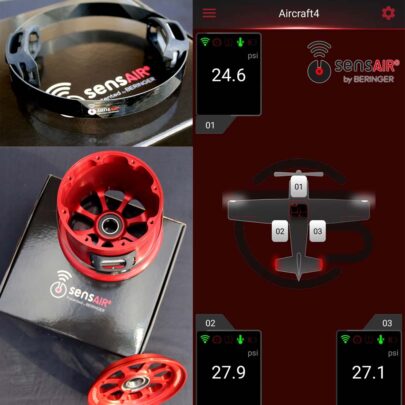 The France-based company with a permanent U.S. operation has numerous products in support of airframes including the unique
The France-based company with a permanent U.S. operation has numerous products in support of airframes including the unique 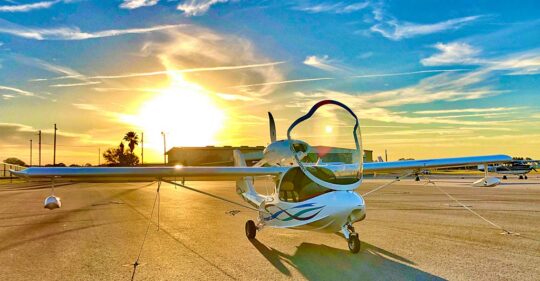 In the last few years Seamax has substantially upgraded their U.S. representation with full-time facilities adjacent to the prestigious campus of Embry Riddle Aeronautical University. From this ideal location they can cover the Eastern U.S.
Now, Seamax is pleased to announce a new dealer based in Tulsa, Oklahoma. The seaplane maker now offers support, training, and sales for several Midwestern states. The new business is called Central Seaplanes and they become the official sales agent and brand representative for Oklahoma, Arkansas, Missouri, Kansas, Colorado, New Mexico, and Texas.
In the last few years Seamax has substantially upgraded their U.S. representation with full-time facilities adjacent to the prestigious campus of Embry Riddle Aeronautical University. From this ideal location they can cover the Eastern U.S.
Now, Seamax is pleased to announce a new dealer based in Tulsa, Oklahoma. The seaplane maker now offers support, training, and sales for several Midwestern states. The new business is called Central Seaplanes and they become the official sales agent and brand representative for Oklahoma, Arkansas, Missouri, Kansas, Colorado, New Mexico, and Texas.
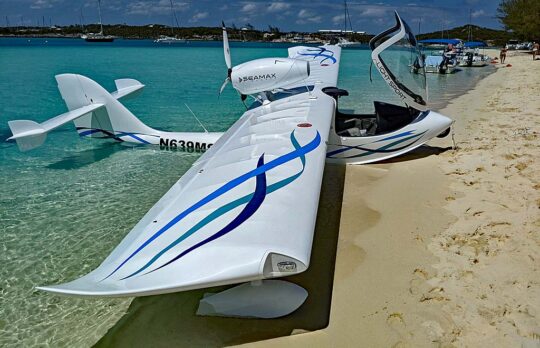 The Oklahoma dealer recently acquired two fully-equipped Seamax M-22 aircraft to their fleet and. One M-22 is equipped with IFR gear, which allows a pilot in training to log instrument hours at competitive rates.
Central Seaplanes, LLC is a father-daughter, veteran-owned business represented by Kira and Todd Lang.
Todd is a former fighter pilot with 40 years of aviation experience and 11,000 logged hours with CFI, CFII, and MEI instructor credentials. Currently, he is an international Boeing 767 Captain for a major U.S. airline. Todd also holds a Master's degree in Business Administration from Embry Riddle.
Kira has an Associate degree in aircrew safety systems technology, a Bachelor's degree in aviation management and a Master's degree in aviation and space science. She is currently finishing her doctorate. Kira received her Private Pilot certificate when she was 18 years old.
Kira said she has always dreamed of starting her own business with her dad. She has a passion for aviation and has thrived in the industry. She intends to dedicate her time to the success of Central Seaplanes and their association with Seamax aircraft.
The Oklahoma dealer recently acquired two fully-equipped Seamax M-22 aircraft to their fleet and. One M-22 is equipped with IFR gear, which allows a pilot in training to log instrument hours at competitive rates.
Central Seaplanes, LLC is a father-daughter, veteran-owned business represented by Kira and Todd Lang.
Todd is a former fighter pilot with 40 years of aviation experience and 11,000 logged hours with CFI, CFII, and MEI instructor credentials. Currently, he is an international Boeing 767 Captain for a major U.S. airline. Todd also holds a Master's degree in Business Administration from Embry Riddle.
Kira has an Associate degree in aircrew safety systems technology, a Bachelor's degree in aviation management and a Master's degree in aviation and space science. She is currently finishing her doctorate. Kira received her Private Pilot certificate when she was 18 years old.
Kira said she has always dreamed of starting her own business with her dad. She has a passion for aviation and has thrived in the industry. She intends to dedicate her time to the success of Central Seaplanes and their association with Seamax aircraft.
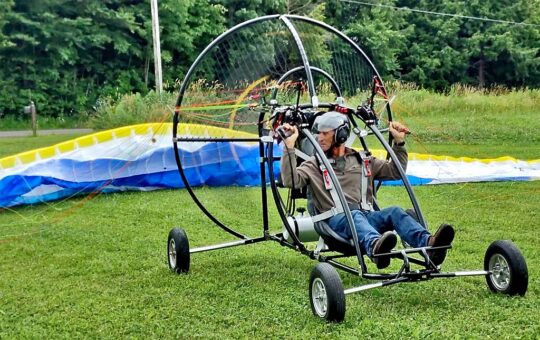 This quad — a term describing the four wheeled carriage some powered paraglider enthusiasts prefer — “is a new concept,” said Erin Thorson about designer Dan Feldman's work. Dragon will make its official debut at AirVenture 2021. Thorson is a 30+ year A&P and former Air Force aviator.
"Considerable research and thought have been put into producing a high quality seated powered paraglider that meets all FAR 103 requirements," wrote Erin. Dragon PPG is aimed at taller and heavier PPG pilots. The design features a roll cage for protection. Such a configuration is common in powered parachutes (different aircraft, if you aren't familiar) but quads have previously been very light weight construction that mainly aimed to provide some structure to accommodate wheels, and not much more.
Based on Rotax 503 power, Erin described thrust of the engine as "incredible!" Dragon was weight tested at 4Gs assuming a 220-pound pilot. Commonly, powered paragliders prefer the lightweight, higher-revving Polini engine (see next news item).
This quad — a term describing the four wheeled carriage some powered paraglider enthusiasts prefer — “is a new concept,” said Erin Thorson about designer Dan Feldman's work. Dragon will make its official debut at AirVenture 2021. Thorson is a 30+ year A&P and former Air Force aviator.
"Considerable research and thought have been put into producing a high quality seated powered paraglider that meets all FAR 103 requirements," wrote Erin. Dragon PPG is aimed at taller and heavier PPG pilots. The design features a roll cage for protection. Such a configuration is common in powered parachutes (different aircraft, if you aren't familiar) but quads have previously been very light weight construction that mainly aimed to provide some structure to accommodate wheels, and not much more.
Based on Rotax 503 power, Erin described thrust of the engine as "incredible!" Dragon was weight tested at 4Gs assuming a 220-pound pilot. Commonly, powered paragliders prefer the lightweight, higher-revving Polini engine (see next news item).
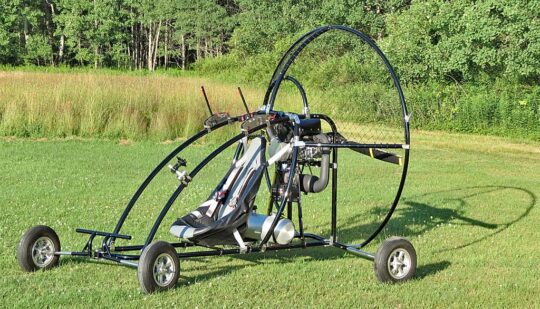 "Last week, Eric Dufour, a world-renowned paragliding pioneer and well respected paramotor instructor, personally flew the Dragon PPG and loved everything about it," wrote Erin. "I have witnessed the Dragon fly; it is a rocket!"
"Last week, Eric Dufour, a world-renowned paragliding pioneer and well respected paramotor instructor, personally flew the Dragon PPG and loved everything about it," wrote Erin. "I have witnessed the Dragon fly; it is a rocket!"
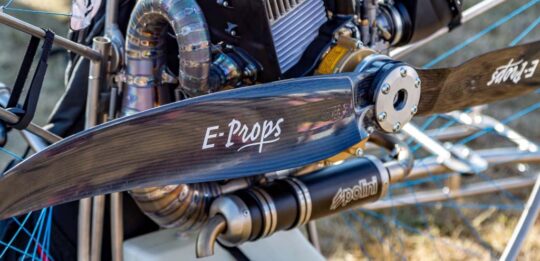 “The propeller is a very important equipment to succeed in this kind of competition,” the company wrote. “
“The propeller is a very important equipment to succeed in this kind of competition,” the company wrote. “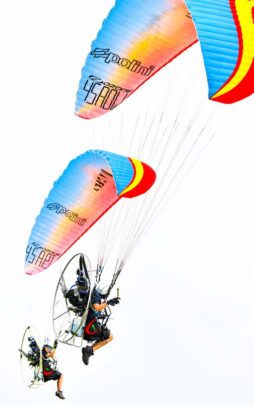 In second position was Jeremy Penone using the super-tested Thor 250.
In third, winning the bronze medal, was Marie Mateos also using the new Thor 303. Marie reached a new goal with Thor
In second position was Jeremy Penone using the super-tested Thor 250.
In third, winning the bronze medal, was Marie Mateos also using the new Thor 303. Marie reached a new goal with Thor 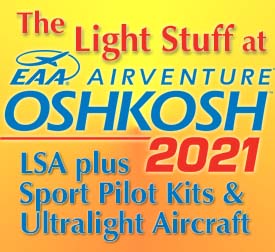 …but, of course, all the above is merely the tip of a large iceberg.
I hope to achieve sensory overload at Oshkosh '21 and I will do my best to transmit that excitement to you. Watch for the bright orange logo denoting coverage from the big show.
…but, of course, all the above is merely the tip of a large iceberg.
I hope to achieve sensory overload at Oshkosh '21 and I will do my best to transmit that excitement to you. Watch for the bright orange logo denoting coverage from the big show.
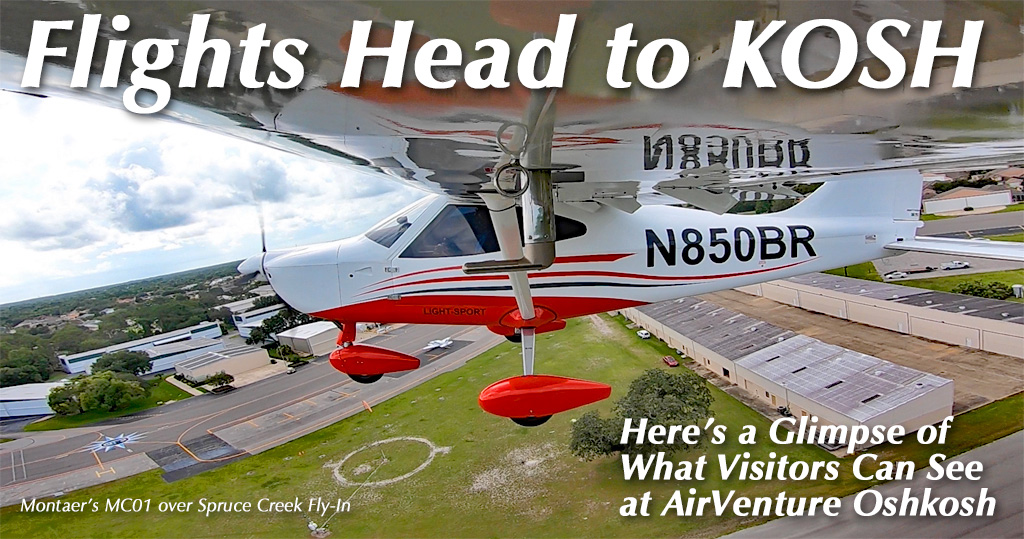
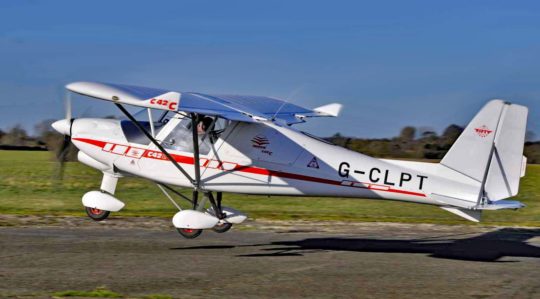 Yet no one can dispute that C42 — once rebadged as Cyclone for American buyers — has for many years been THE success story in Germany. This southern German company celebrated its 50th anniversary in 2020.
Our favorite British aerojournalist,
Yet no one can dispute that C42 — once rebadged as Cyclone for American buyers — has for many years been THE success story in Germany. This southern German company celebrated its 50th anniversary in 2020.
Our favorite British aerojournalist,  Now in its "C" model configuration, C42 is one of the most successful European microlights (a category between Part 103 ultralights and LSA, but closer to the latter). Comco Ikarus has evolved the machine into a fine airplane.
In England, C42 is sold by
Now in its "C" model configuration, C42 is one of the most successful European microlights (a category between Part 103 ultralights and LSA, but closer to the latter). Comco Ikarus has evolved the machine into a fine airplane.
In England, C42 is sold by 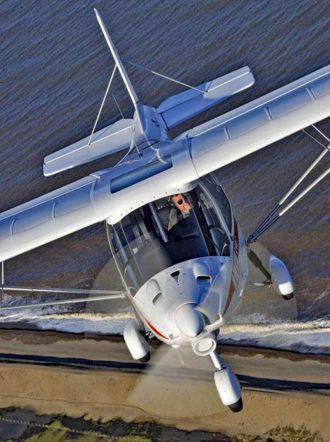
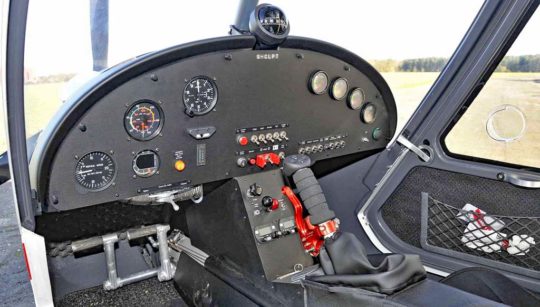 Aft of the cockpit there’s a frangible cover which the BRS rocket fires through, and a very large quickly removable panel on the port side, through which the fuel quantity can be seen and a lot of the interior structure visually inspected. The rear baggage bay can hold up to 100 pounds, weight and balance allowing.
C42C's tail consists of a strut-braced tailplane and separate elevator, a slightly swept-back vertical stabilizer, which carries a broad-chord rudder and a small ventral fin tail bumper. Wings, tail, flaps and control surfaces are all covered in XLAM (a type of sturdy, dimensionally-stable fabric sailcloth) with Tanara Teflon thread (which is impervious to UV light) used for the stitching.
Aft of the cockpit there’s a frangible cover which the BRS rocket fires through, and a very large quickly removable panel on the port side, through which the fuel quantity can be seen and a lot of the interior structure visually inspected. The rear baggage bay can hold up to 100 pounds, weight and balance allowing.
C42C's tail consists of a strut-braced tailplane and separate elevator, a slightly swept-back vertical stabilizer, which carries a broad-chord rudder and a small ventral fin tail bumper. Wings, tail, flaps and control surfaces are all covered in XLAM (a type of sturdy, dimensionally-stable fabric sailcloth) with Tanara Teflon thread (which is impervious to UV light) used for the stitching.
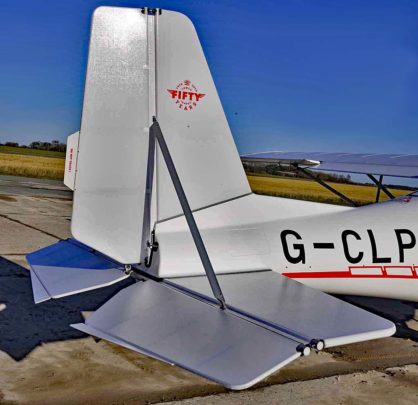 Less obvious changes include a significant revision of the wing structure with more use of carbon fiber. C42C's cockpit roof has been completely redesigned and the doors are now hung on redesigned hinges.
A sturdy hydro-pneumatic tricycle undercarriage offers nosewheel steering via the rudder pedals and carries
Less obvious changes include a significant revision of the wing structure with more use of carbon fiber. C42C's cockpit roof has been completely redesigned and the doors are now hung on redesigned hinges.
A sturdy hydro-pneumatic tricycle undercarriage offers nosewheel steering via the rudder pedals and carries 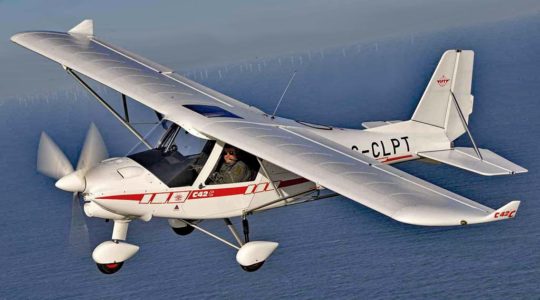 After fastening my four-point harness, I raised the throttle into its correct position and familiarized myself with the cockpit. Throttles on both sides fold flat to aid ingress and egress.
C42C's instrument panel is large and could easily carry just about every possible permutation of instrumentation, from very basic analog to the latest
After fastening my four-point harness, I raised the throttle into its correct position and familiarized myself with the cockpit. Throttles on both sides fold flat to aid ingress and egress.
C42C's instrument panel is large and could easily carry just about every possible permutation of instrumentation, from very basic analog to the latest 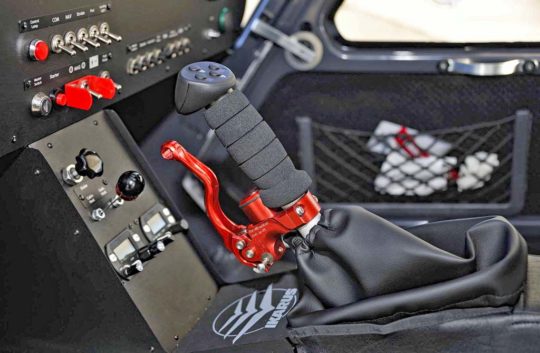 A central column braces the instrument panel and carries push/pull plungers for the choke; cabin heat and carb heat; a transceiver and transponder; and a toggle switch for the intercom. C42C's fuel selector is located at the base of the central column by the pilot’s right leg; easy to see and reach. Large map pockets are built into the doors.
A center stick features a comfortable foam grip with buttons for electric elevator trim and a bicycle-type brake lever with integral park brake. The large handbrake-type flap lever is set into the roof, in front of a red T-handle for the BRS.
A central column braces the instrument panel and carries push/pull plungers for the choke; cabin heat and carb heat; a transceiver and transponder; and a toggle switch for the intercom. C42C's fuel selector is located at the base of the central column by the pilot’s right leg; easy to see and reach. Large map pockets are built into the doors.
A center stick features a comfortable foam grip with buttons for electric elevator trim and a bicycle-type brake lever with integral park brake. The large handbrake-type flap lever is set into the roof, in front of a red T-handle for the BRS.
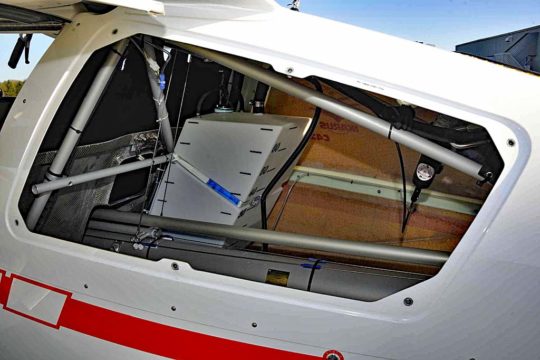 With my solo loaded weight about 200 pounds below gross, a paved runway, and a brisk headwind, I anticipated a stellar take off and climb characteristics and I was not disappointed! The prop was pitched for cruise but you’d never guess. I reached 1,000 feet above the runway before the airfield boundary.
After shooting the air-to-air photos, the camera ship departed and I took a look at C42C's general handling. All controls were nicely harmonized and authoritative. The roll rate in particular is much more sprightly than the C42A, while the stick forces felt lower than I remembered, no doubt due to the spades mounted on the ailerons. A short center stick does not provide much mechanical advantage but the spades help. Control around both pitch and yaw axes was equally effective, and keeping the slip-ball centered took only small amounts of rudder. The electric pitch trim is effective and nicely geared.
With my solo loaded weight about 200 pounds below gross, a paved runway, and a brisk headwind, I anticipated a stellar take off and climb characteristics and I was not disappointed! The prop was pitched for cruise but you’d never guess. I reached 1,000 feet above the runway before the airfield boundary.
After shooting the air-to-air photos, the camera ship departed and I took a look at C42C's general handling. All controls were nicely harmonized and authoritative. The roll rate in particular is much more sprightly than the C42A, while the stick forces felt lower than I remembered, no doubt due to the spades mounted on the ailerons. A short center stick does not provide much mechanical advantage but the spades help. Control around both pitch and yaw axes was equally effective, and keeping the slip-ball centered took only small amounts of rudder. The electric pitch trim is effective and nicely geared.
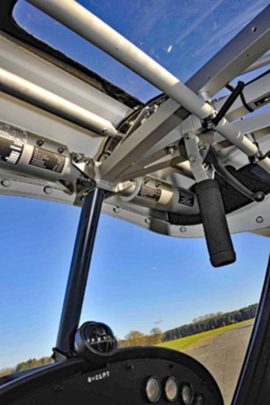 Moving onto an examination of the stick-free stability around all three axes reveals the directional stability is definitely soft to the left and neutral to the right, while spiral stability is slightly positive from the right and neutral to the left. The longitudinal stability is quite strong; a 10-knot displacement from a trimmed speed of 70 knots resulting in a long wavelength low amplitude phugoid that damped itself out after three lazy oscillations. Importantly, C42C is not divergent around any axes.
Slowing down to explore the slow speed side of the flight envelope revealed no unpleasant traits. As the speed reduced past 60 knots, I moved the flap lever to +2, which lowers the flaps to their maximum of 40° and causes a significant change in pitch trim, although this is easily trimmed out.
With full flaps and a reasonable amount of power C42C showed no desire to stall. At modest stall entry and with the nose just above the horizon, C42C mushed and wallowed while the sink rate increased. No stall warning is provided but you feel a mild aerodynamic buffet. Hold the stick on the backstop and it hunts slightly in pitch while sinking. Adequate aileron control is available post-stall.
When I used a more aggressive technique C42C stalled with a slight wing drop. At test weight, the wing drop came around 32 knots. Performing a departure stall I retracted flaps to the take-off setting of +1 (15°), opened the throttle and pitched up …and up …and up! It feels as if I’m lying on my back before the wing finally gives up and the nose falls through.
Moving onto an examination of the stick-free stability around all three axes reveals the directional stability is definitely soft to the left and neutral to the right, while spiral stability is slightly positive from the right and neutral to the left. The longitudinal stability is quite strong; a 10-knot displacement from a trimmed speed of 70 knots resulting in a long wavelength low amplitude phugoid that damped itself out after three lazy oscillations. Importantly, C42C is not divergent around any axes.
Slowing down to explore the slow speed side of the flight envelope revealed no unpleasant traits. As the speed reduced past 60 knots, I moved the flap lever to +2, which lowers the flaps to their maximum of 40° and causes a significant change in pitch trim, although this is easily trimmed out.
With full flaps and a reasonable amount of power C42C showed no desire to stall. At modest stall entry and with the nose just above the horizon, C42C mushed and wallowed while the sink rate increased. No stall warning is provided but you feel a mild aerodynamic buffet. Hold the stick on the backstop and it hunts slightly in pitch while sinking. Adequate aileron control is available post-stall.
When I used a more aggressive technique C42C stalled with a slight wing drop. At test weight, the wing drop came around 32 knots. Performing a departure stall I retracted flaps to the take-off setting of +1 (15°), opened the throttle and pitched up …and up …and up! It feels as if I’m lying on my back before the wing finally gives up and the nose falls through.
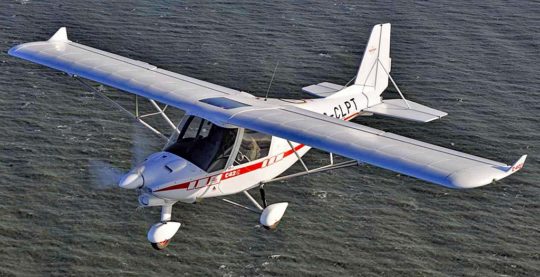 Comco Ikarus reports a glide angle of 11:1 (a Cessna 150 is about 9.5:1), while minimum sink rate is around 400 feet per minute.
As I’d anticipated, this C42 is considerably quicker than the earlier models, and because the air is as smooth as glass I was relaxed as the ASI needle slipped into the yellow arc. C42C was still accelerating at 5000 rpm. Top-of-the-green arc is 82 knots at 2,000 feet and 4800 rpm. At about four gallons per hour, you can comfortably plan for 300 nautical miles with a 30-minute reserve. That’s about 25 nautical air miles per gallon.
As I got back to base, I did a few take offs and landing, and for the first time I found the roof-mounted flap lever slightly intrusive; you’re constantly swapping hands. It’s not a big deal, but writers have to complain about something.
Comco Ikarus reports a glide angle of 11:1 (a Cessna 150 is about 9.5:1), while minimum sink rate is around 400 feet per minute.
As I’d anticipated, this C42 is considerably quicker than the earlier models, and because the air is as smooth as glass I was relaxed as the ASI needle slipped into the yellow arc. C42C was still accelerating at 5000 rpm. Top-of-the-green arc is 82 knots at 2,000 feet and 4800 rpm. At about four gallons per hour, you can comfortably plan for 300 nautical miles with a 30-minute reserve. That’s about 25 nautical air miles per gallon.
As I got back to base, I did a few take offs and landing, and for the first time I found the roof-mounted flap lever slightly intrusive; you’re constantly swapping hands. It’s not a big deal, but writers have to complain about something.

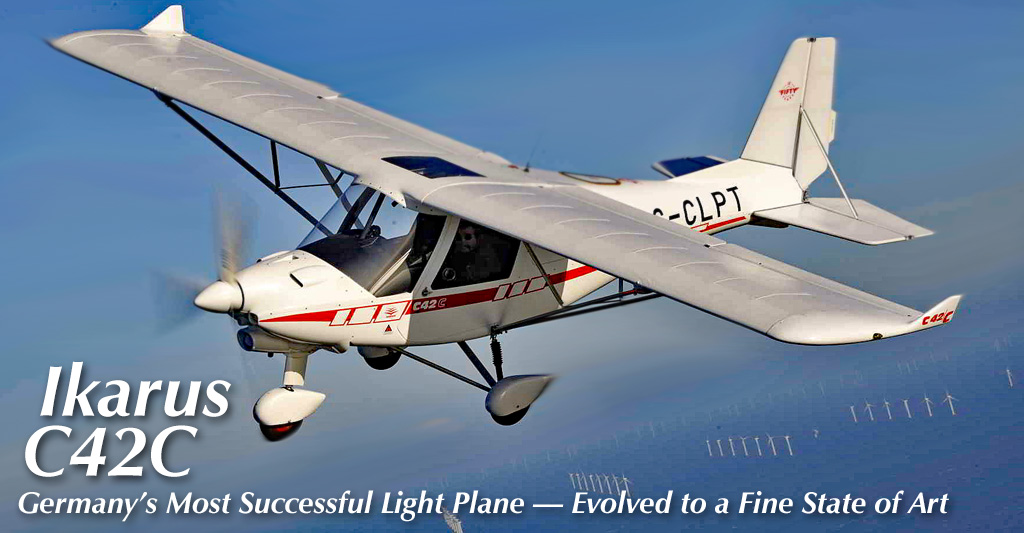
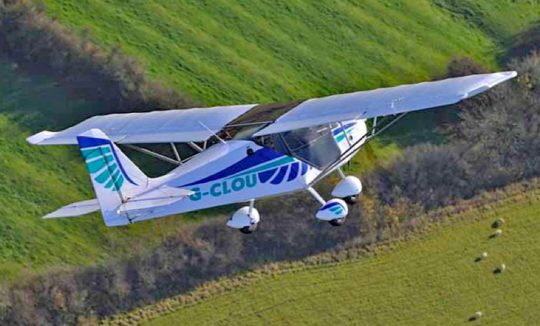 For far too long, the more bigoted aviators among us considered such an aircraft to be little more an overweight hang glider powered by a second-hand lawn mower engine and barely capable of flying fast enough to kill you. Noisy, slow, and smelly — they were considerably less than satisfactory. However, times change and this class of flying machine has changed more than most.
Designed by Frenchman Phillippe Prevot in the early '90s, the original Skyranger was an object lesson in KISS (Keep It Simple, Stupid). Prevot’s intent was that anyone competent with basic tools could build it, as there was no bending, composites, or welding involved. It was to be covered in an equally simple material, Dacron sailcloth.
Easy to build, maintain and fly, more than 1,600 have been produced; nearly 300 are registered in England alone. Beside numerous minor improvements, fundamentally Skyranger has changed little: the ventral fin has been replaced by a taller fin and the wingspan has been reduced.
For far too long, the more bigoted aviators among us considered such an aircraft to be little more an overweight hang glider powered by a second-hand lawn mower engine and barely capable of flying fast enough to kill you. Noisy, slow, and smelly — they were considerably less than satisfactory. However, times change and this class of flying machine has changed more than most.
Designed by Frenchman Phillippe Prevot in the early '90s, the original Skyranger was an object lesson in KISS (Keep It Simple, Stupid). Prevot’s intent was that anyone competent with basic tools could build it, as there was no bending, composites, or welding involved. It was to be covered in an equally simple material, Dacron sailcloth.
Easy to build, maintain and fly, more than 1,600 have been produced; nearly 300 are registered in England alone. Beside numerous minor improvements, fundamentally Skyranger has changed little: the ventral fin has been replaced by a taller fin and the wingspan has been reduced.
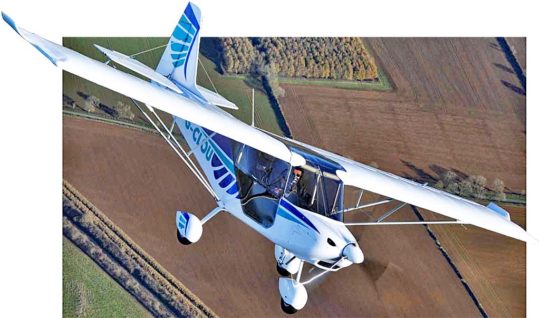 Flylight's main subcontractor is Aeros, based in Kiev, Ukraine. Aeros make some of the world's best hang gliders; they are experts in tube and fabric work. They've built Skyrangers for many years. Today, Nynjas are assembled in the UK.
Nynja's airframe is constructed primarily of straight, pin-jointed, aircraft-grade aluminum tubing, covered with a combination of non-structural composite sheets for the fuselage and pre-sewn polyester Xlam fabric for the wings and tailplane. An interesting feature (and one that flags up how speedy the Nynja is) is that the wings feature foam spacers that ensure the aerofoil retains its shape at higher speeds. All the primary controls are actuated by cables, as is the elevator trim. The tailplane is wire-braced and the strut-braced wings feature upswept winglets. An excellent option allows the wings to be folded back for ease of storage.
Flylight's main subcontractor is Aeros, based in Kiev, Ukraine. Aeros make some of the world's best hang gliders; they are experts in tube and fabric work. They've built Skyrangers for many years. Today, Nynjas are assembled in the UK.
Nynja's airframe is constructed primarily of straight, pin-jointed, aircraft-grade aluminum tubing, covered with a combination of non-structural composite sheets for the fuselage and pre-sewn polyester Xlam fabric for the wings and tailplane. An interesting feature (and one that flags up how speedy the Nynja is) is that the wings feature foam spacers that ensure the aerofoil retains its shape at higher speeds. All the primary controls are actuated by cables, as is the elevator trim. The tailplane is wire-braced and the strut-braced wings feature upswept winglets. An excellent option allows the wings to be folded back for ease of storage.
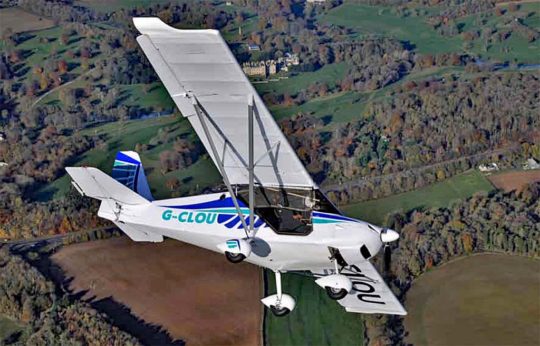 Earlier Skyrangers were powered by several different engines, including the Jabiru 2200, HKS and BMW R100, but these days the
Earlier Skyrangers were powered by several different engines, including the Jabiru 2200, HKS and BMW R100, but these days the 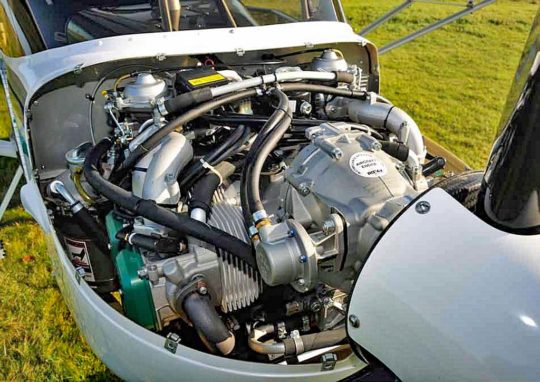 All three wheels feature snug fitting wheel pants. Nynja's main gear is supported by aluminium "half springs" bolted to a steel center tube and feature hydraulic
All three wheels feature snug fitting wheel pants. Nynja's main gear is supported by aluminium "half springs" bolted to a steel center tube and feature hydraulic 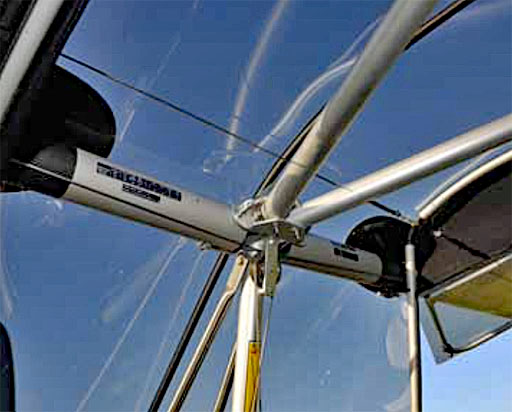
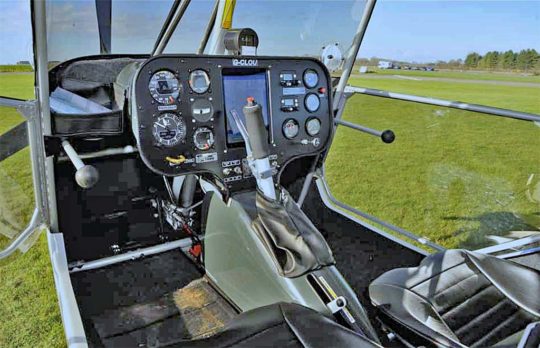 Rolling out onto the runway I opened the Rotax up to full power. With 13 gallons of fuel on board Nynja was right on the 992-pound gross weight. It was cool and I checked a slight crosswind from starboard.
With a power-to-weight ratio of less than ten pounds per horsepower, acceleration was excellent and after what seemed a ridiculously short ground roll, the Nynja literally leapt off the runway and clawed itself skyward at an impressively steep angle. With the VSI indicating in excess of 1,200 fpm and a relatively low forward speed of only 62 knots, we crossed the airfield boundary already at more than 1,000 feet. At such an aggressive climb, Nynja's nose was quite pitched up, greatly reducing the field of view, but even lowering it to more a cruise-climb attitude still produced about 700 feet per minute of climb at 80 knots and 5,000 rpm.
With light weight, plenty of power, and crisp controls joining up with Al and Keith in the EuroFox cameraship was easy; collecting the pictures in this article didn’t take long.
Rolling out onto the runway I opened the Rotax up to full power. With 13 gallons of fuel on board Nynja was right on the 992-pound gross weight. It was cool and I checked a slight crosswind from starboard.
With a power-to-weight ratio of less than ten pounds per horsepower, acceleration was excellent and after what seemed a ridiculously short ground roll, the Nynja literally leapt off the runway and clawed itself skyward at an impressively steep angle. With the VSI indicating in excess of 1,200 fpm and a relatively low forward speed of only 62 knots, we crossed the airfield boundary already at more than 1,000 feet. At such an aggressive climb, Nynja's nose was quite pitched up, greatly reducing the field of view, but even lowering it to more a cruise-climb attitude still produced about 700 feet per minute of climb at 80 knots and 5,000 rpm.
With light weight, plenty of power, and crisp controls joining up with Al and Keith in the EuroFox cameraship was easy; collecting the pictures in this article didn’t take long.
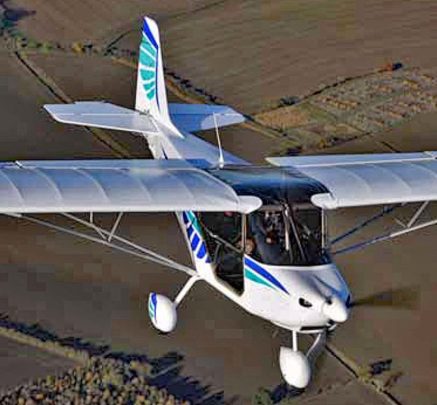 For a high wing aircraft, the visibility is quite good, although as is a feature of practically all-high wing aircraft, it is a tiny bit blind in the turn. Another nice touch is the transparent panel in the roof, as if the aircraft is rolled into a very tight turn it is possible to look through the roof. The controls all seemed quite nicely harmonised and authoritative. The roll rate in particular is distinctly sprightly, while both pitch and yaw control were equally effective. Trim is effective.
Moving on to an exploration of the stick-free stability around all three axes, I get the impression the Nynja is strongly positive longitudinally, weakly positive directionally, and neutral laterally.
Slowing down to explore the low speed side of the flight envelope revealed no disagreeable mannerisms. Indeed, with flaps down and carrying a reasonable amount of power the Nynja showed no desire to stall at all, but a more vigorous approach to the stall with the engine off produced a more positive break at about 33 knots, combined with a slight wing drop which was easily controlled by the rudder. I increase power for a look at a departure stall and, as expected, this maneuver provoked a slightly more vigorous response, although the ensuing stall was easily recovered from with minimal height loss. Flaps up, the stall is still less than 40.
For a high wing aircraft, the visibility is quite good, although as is a feature of practically all-high wing aircraft, it is a tiny bit blind in the turn. Another nice touch is the transparent panel in the roof, as if the aircraft is rolled into a very tight turn it is possible to look through the roof. The controls all seemed quite nicely harmonised and authoritative. The roll rate in particular is distinctly sprightly, while both pitch and yaw control were equally effective. Trim is effective.
Moving on to an exploration of the stick-free stability around all three axes, I get the impression the Nynja is strongly positive longitudinally, weakly positive directionally, and neutral laterally.
Slowing down to explore the low speed side of the flight envelope revealed no disagreeable mannerisms. Indeed, with flaps down and carrying a reasonable amount of power the Nynja showed no desire to stall at all, but a more vigorous approach to the stall with the engine off produced a more positive break at about 33 knots, combined with a slight wing drop which was easily controlled by the rudder. I increase power for a look at a departure stall and, as expected, this maneuver provoked a slightly more vigorous response, although the ensuing stall was easily recovered from with minimal height loss. Flaps up, the stall is still less than 40.
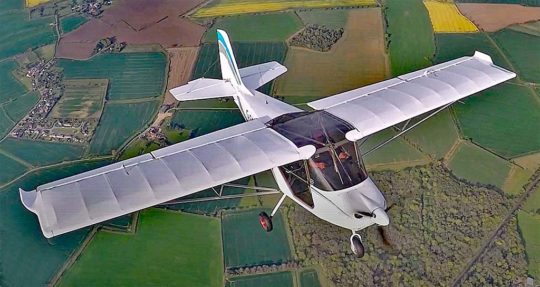 The claimed glide angle is a reasonable 9:1 at 55 knots, while minimum sink is modest at around 500 feet per minute at 45 knots.
Cruise is middle-of-the-range at 95 knots, achieved at 5,100 rpm, giving a true air speed of 101 knots at 3,000 feet with a fuel flow of about 4.75 gallons per hour, but the engine does sound somewhat frenetic. A much more comfortable cruise rpm is 4,000, which still gives an IAS of 70 knots (76 true) and a fuel flow of less than 2.6 gallons per hour and a still-air range of over 400 nautical miles, including Day-VFR reserves.
The claimed glide angle is a reasonable 9:1 at 55 knots, while minimum sink is modest at around 500 feet per minute at 45 knots.
Cruise is middle-of-the-range at 95 knots, achieved at 5,100 rpm, giving a true air speed of 101 knots at 3,000 feet with a fuel flow of about 4.75 gallons per hour, but the engine does sound somewhat frenetic. A much more comfortable cruise rpm is 4,000, which still gives an IAS of 70 knots (76 true) and a fuel flow of less than 2.6 gallons per hour and a still-air range of over 400 nautical miles, including Day-VFR reserves.
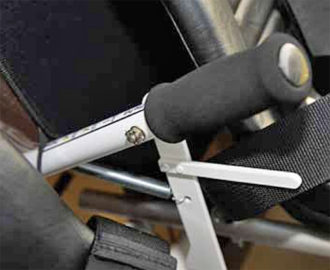 On approach to landing, I nailed the ASI’s needle to 50 with just a smidgen of throttle and then chopped the power. After Nynja's main wheels touched firmly I lowered the nose and applied maximum braking; I actually locked the wheels up and we skidded momentarily on the damp grass. All total I used a little over 300 feet.
Overall, I thought the Nynja a great little aircraft that offers outstanding value for money. It is a lot of aircraft for the money.
What a cracking little aircraft! Fast, frugal and fun, the latest iteration of the seminal Skyranger might just be the best one yet.
On approach to landing, I nailed the ASI’s needle to 50 with just a smidgen of throttle and then chopped the power. After Nynja's main wheels touched firmly I lowered the nose and applied maximum braking; I actually locked the wheels up and we skidded momentarily on the damp grass. All total I used a little over 300 feet.
Overall, I thought the Nynja a great little aircraft that offers outstanding value for money. It is a lot of aircraft for the money.
What a cracking little aircraft! Fast, frugal and fun, the latest iteration of the seminal Skyranger might just be the best one yet.
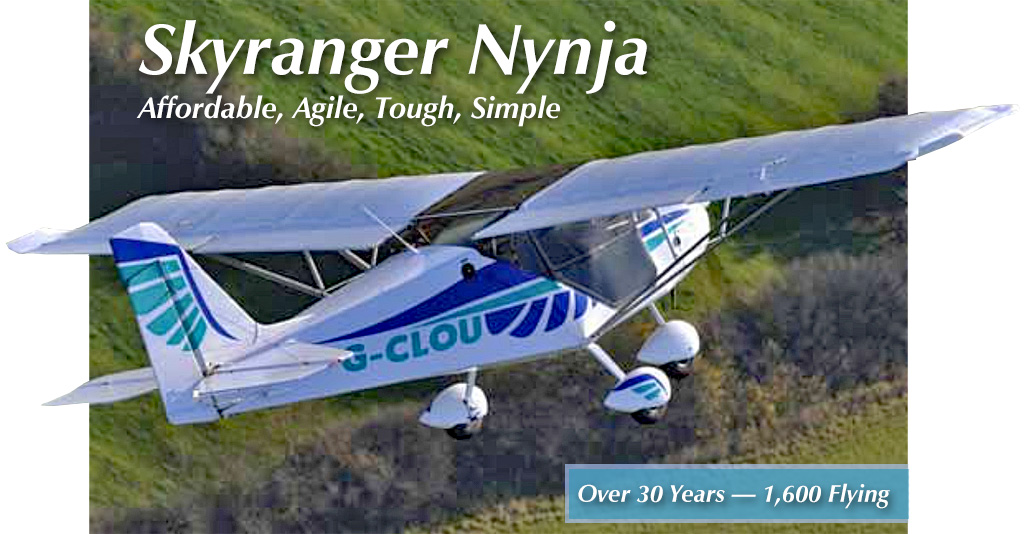
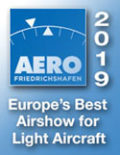 Jetting straight from Sun 'n Fun, we were able to arrive at
Jetting straight from Sun 'n Fun, we were able to arrive at 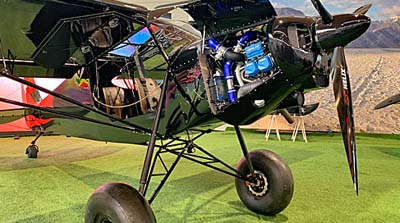 Zlin Ultra with Rotax 915iS
Zlin Ultra with Rotax 915iS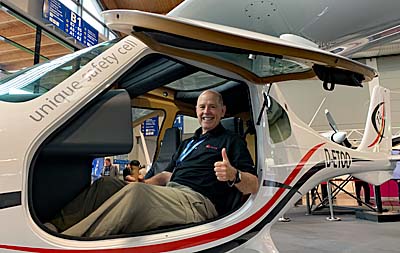
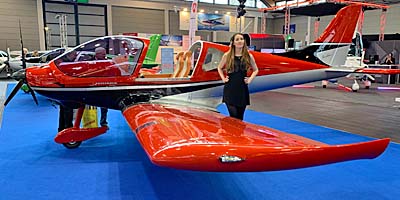 Belmont Aero DW200
Belmont Aero DW200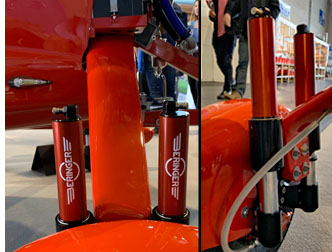 Beringer Everywhere
Beringer Everywhere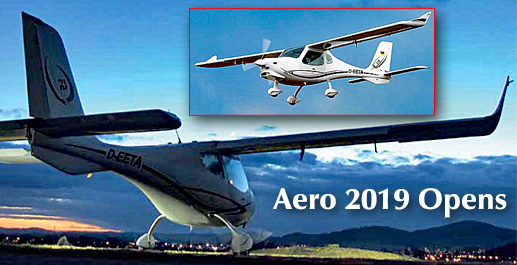
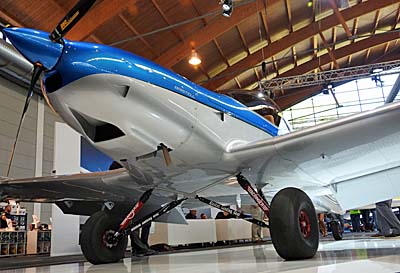 BRM Aero boss and chief design, Milan Bristela, has convincingly proven his visionary credentials. Here's
BRM Aero boss and chief design, Milan Bristela, has convincingly proven his visionary credentials. Here's 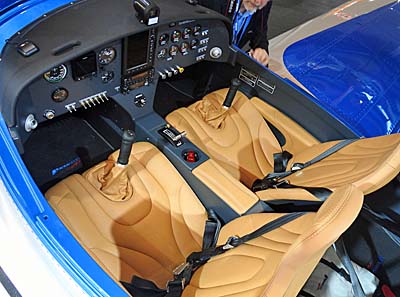 All that space might be useful for another kind of enjoyment: bush flying, landing on river beds, camping …that sort of adventure.
For the new "bush" version of TDO, BRM again did a great job of finishing the interior, both in creature comforts (as seen in the nearby photo) or equipment.
To mount big Alaska tundra tires on their TDO, BRM teamed up with
All that space might be useful for another kind of enjoyment: bush flying, landing on river beds, camping …that sort of adventure.
For the new "bush" version of TDO, BRM again did a great job of finishing the interior, both in creature comforts (as seen in the nearby photo) or equipment.
To mount big Alaska tundra tires on their TDO, BRM teamed up with 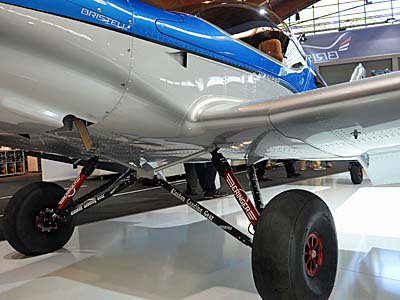 What's great about the Beringer/Alaska adaptation is that it follows Milan's mantra to keep as many new innovations as possible retrofittable to older models. That works here, too, but owners get a bonus.
Through the design of this Bush TDO model, Milan made sure a mechanically-savvy owner can switch back and forth. Use your fiberglass gear and wheel pants to go fast for travel but swap to bush mode when you want to fly for fun on the weekend, maybe at your cottage. Cool, huh? What wonderful versatility.
What's great about the Beringer/Alaska adaptation is that it follows Milan's mantra to keep as many new innovations as possible retrofittable to older models. That works here, too, but owners get a bonus.
Through the design of this Bush TDO model, Milan made sure a mechanically-savvy owner can switch back and forth. Use your fiberglass gear and wheel pants to go fast for travel but swap to bush mode when you want to fly for fun on the weekend, maybe at your cottage. Cool, huh? What wonderful versatility.
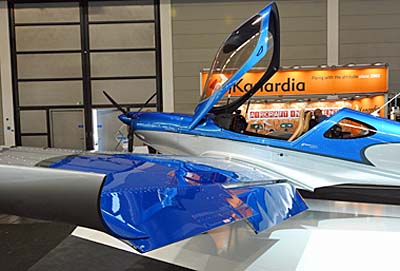 U.S. representation is very strong with
U.S. representation is very strong with 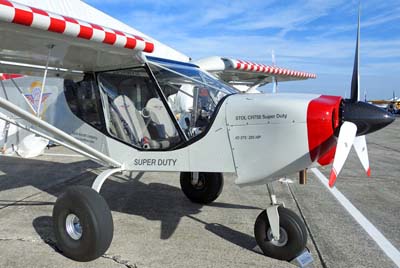 Day two of the year's first show, Sebring was a bit cooler and windier but still a fine day as the photos show. I would guess crowds were as good or better than yesterday not even counting a large contingent of ROTC candidates visiting for the day.
Day two of the year's first show, Sebring was a bit cooler and windier but still a fine day as the photos show. I would guess crowds were as good or better than yesterday not even counting a large contingent of ROTC candidates visiting for the day.
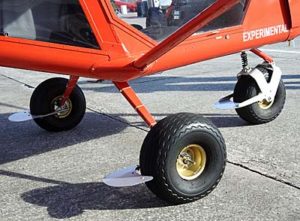 Aeroprakt USA displayed an A22LS model, the Ukraine design featuring vast expanses of clear plastic that deliver massive visibility. The show model had tundra tires with rather unique "footwear" as its tricycle gear used surfaces closer to fenders than wheel pants. They won't provide any drag reduction but will help keep mud or debris splatter off the wings and fuselage. The A-22 also had sliding windows useful for aerial photography.
Aeroprakt USA displayed an A22LS model, the Ukraine design featuring vast expanses of clear plastic that deliver massive visibility. The show model had tundra tires with rather unique "footwear" as its tricycle gear used surfaces closer to fenders than wheel pants. They won't provide any drag reduction but will help keep mud or debris splatter off the wings and fuselage. The A-22 also had sliding windows useful for aerial photography.
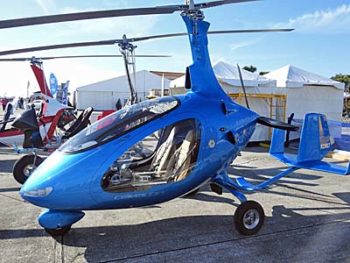 AutoGyro USA
AutoGyro USA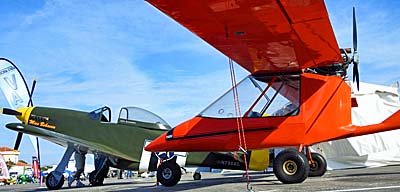 It was fun to get caught up with John Williams of
It was fun to get caught up with John Williams of 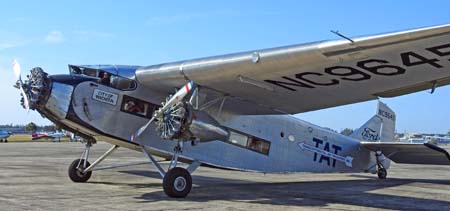
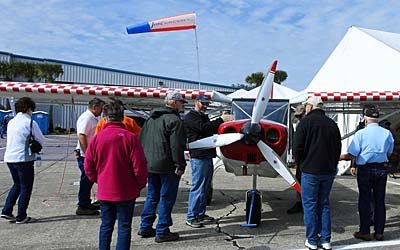
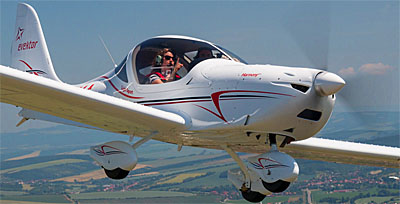 My video partner must be working around the clock as he prepared a blizzard of videos for release starting November 1st.
As you see in the list below, 20 videos will soon be available. I hope you'll enjoy them.
Besides giving you info on various aircraft to see at the event, we hope to encourage you to attend
My video partner must be working around the clock as he prepared a blizzard of videos for release starting November 1st.
As you see in the list below, 20 videos will soon be available. I hope you'll enjoy them.
Besides giving you info on various aircraft to see at the event, we hope to encourage you to attend 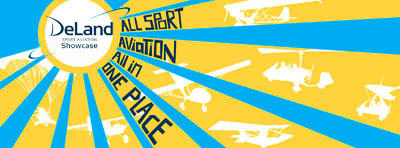 According to a local newspaper, "More than 6,000 people are expected on the DeLand Municipal Airport Thursday, November 2 through Saturday, the 4th, to inspect more than 100 aircraft."
The reporter went on to say that DeLand expects to "top the 1,000 flight operations recorded last year."
Hours all three days are 9 AM to 5 PM. General admission for adults costs $20 each day, or $40 for a three-day pass. Lower prices are available for youth aged 11-17 and kids under 10 get in free. The entrance and free parking for DeLand Showcase are off Industrial Way on the northwest side of the airport.
Here's the posting schedule for the gusher of videos you can watch. All these aircraft are expected at DeLand.
According to a local newspaper, "More than 6,000 people are expected on the DeLand Municipal Airport Thursday, November 2 through Saturday, the 4th, to inspect more than 100 aircraft."
The reporter went on to say that DeLand expects to "top the 1,000 flight operations recorded last year."
Hours all three days are 9 AM to 5 PM. General admission for adults costs $20 each day, or $40 for a three-day pass. Lower prices are available for youth aged 11-17 and kids under 10 get in free. The entrance and free parking for DeLand Showcase are off Industrial Way on the northwest side of the airport.
Here's the posting schedule for the gusher of videos you can watch. All these aircraft are expected at DeLand.
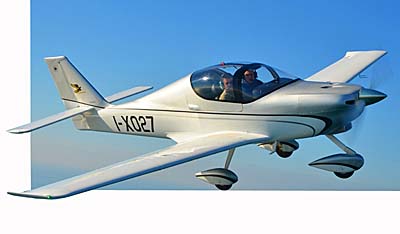
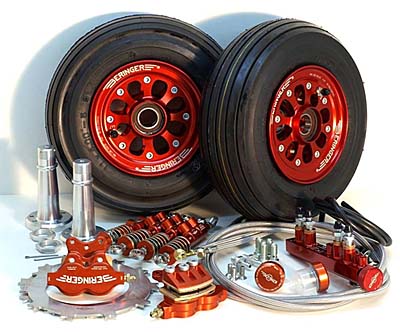 Nov. 1, 2017 10 a.m.
Nov. 1, 2017 10 a.m. 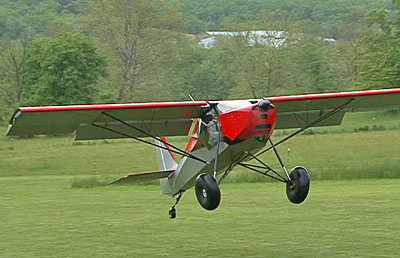
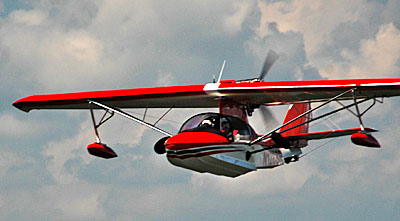 Nov. 1, 2017 8 p.m.
Nov. 1, 2017 8 p.m. 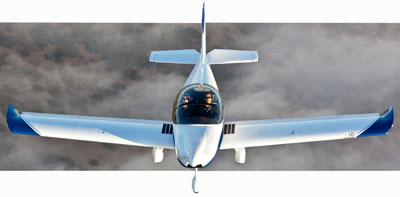 Nov. 1, 2017 11 p.m.
Nov. 1, 2017 11 p.m. 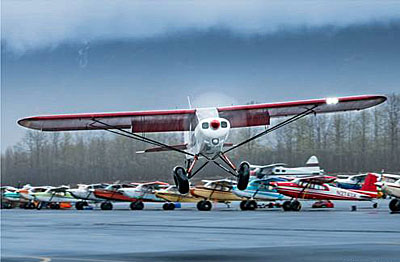
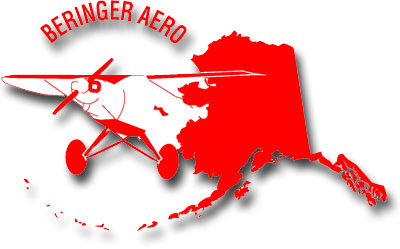 Beringer, know for great ideas like their
Beringer, know for great ideas like their 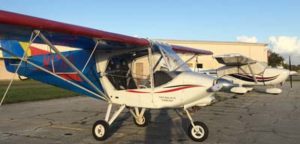
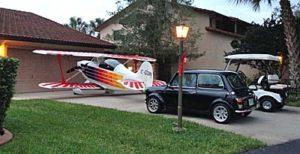
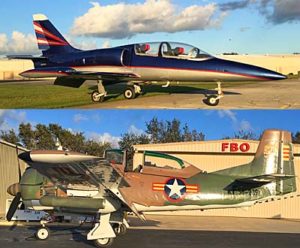
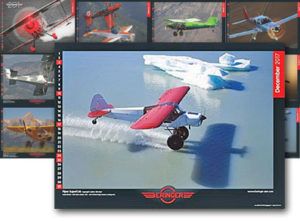
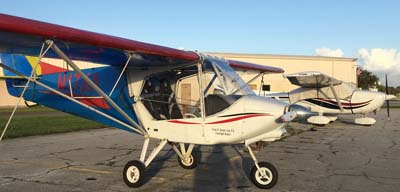
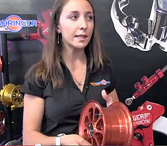
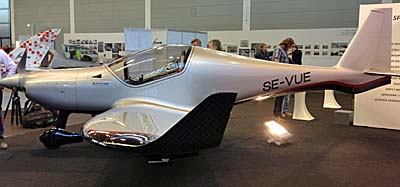
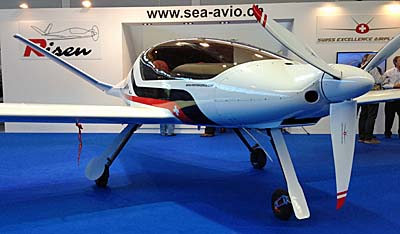
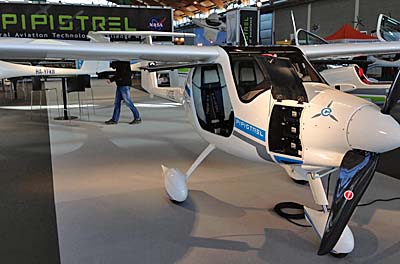
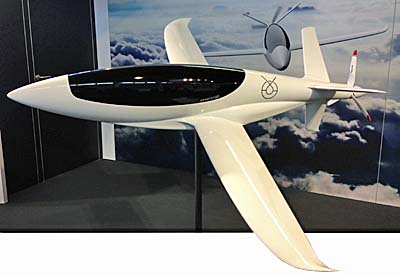
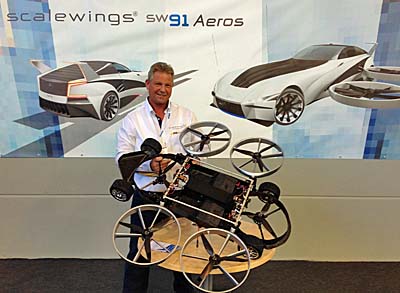
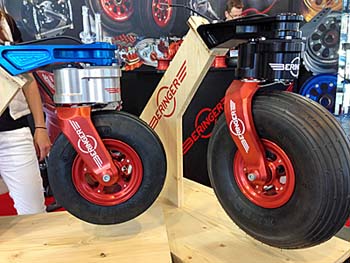

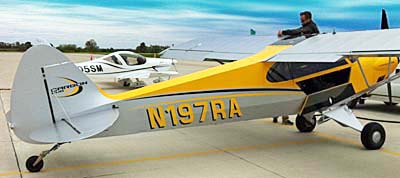 Elements are basic components of nature. As in our first part, I see Oshkosh Elements as fascinating ideas other than airframes or engines. One such worthy idea is Beringer's new anti-groundloop tailwheel. Before we talk about their innovation, though, let's take a quick glance at tailwheel design popularity. Cub-like models and other taildraggers account for more than 20% of the LSA fleet today. Tricycle gear may dominate but lots of pilots believe a tailwheel aircraft is the "proper" gear for an airplane with more machismo, more bush-capability, more aerodynamic efficiency (less drag) ... you name it, many pilots just love taildraggers. Tricycle gear pilots, however, not so much. The reason? Trigear landings tend to self correct regarding keeping the airplane straight on the runway. Tailwheel aircraft threaten the dreaded ground loop. Since this sounds — and can be — scary, lots of Cessna or Piper-trained pilots avoid flying taildraggers.
Elements are basic components of nature. As in our first part, I see Oshkosh Elements as fascinating ideas other than airframes or engines. One such worthy idea is Beringer's new anti-groundloop tailwheel. Before we talk about their innovation, though, let's take a quick glance at tailwheel design popularity. Cub-like models and other taildraggers account for more than 20% of the LSA fleet today. Tricycle gear may dominate but lots of pilots believe a tailwheel aircraft is the "proper" gear for an airplane with more machismo, more bush-capability, more aerodynamic efficiency (less drag) ... you name it, many pilots just love taildraggers. Tricycle gear pilots, however, not so much. The reason? Trigear landings tend to self correct regarding keeping the airplane straight on the runway. Tailwheel aircraft threaten the dreaded ground loop. Since this sounds — and can be — scary, lots of Cessna or Piper-trained pilots avoid flying taildraggers.
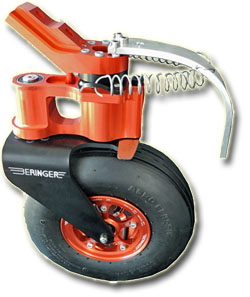 Several other reporters covered
Several other reporters covered 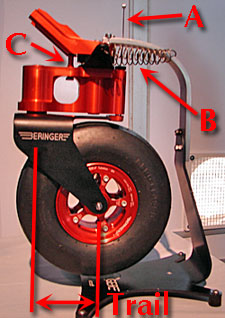 Another journalist, AIN's Matt Thurber, wrote: "On normal tailwheel designs, the pivot axis of a steerable tailwheel is offset from the wheel axis, and the distance between the two is called the trail (illustrated photo), according to engineer Claire Beringer. "When you increase this [trail], maneuverability increases but stability decreases." While pilots appreciate the trail feature that allows the tailwheel to pivot for improved ground handling, if there is a disturbance during landing, such as a crosswind gust, the force on the tailwheel tends to cause the wheel itself to [steer] just when it would be more helpful for the pilot if the wheel were to remain straight. "The [tailwheel] spring is not strong enough to retain the tailwheel in its axis," she said. With the wheel in the locked position, the wheel can't pivot but can still be used to steer a limited amount right or left. By pulling a cable in the cockpit (simulated by "A"), the pilot adds the trail to the tailwheel assembly, which can then pivot in any direction."
Another journalist, AIN's Matt Thurber, wrote: "On normal tailwheel designs, the pivot axis of a steerable tailwheel is offset from the wheel axis, and the distance between the two is called the trail (illustrated photo), according to engineer Claire Beringer. "When you increase this [trail], maneuverability increases but stability decreases." While pilots appreciate the trail feature that allows the tailwheel to pivot for improved ground handling, if there is a disturbance during landing, such as a crosswind gust, the force on the tailwheel tends to cause the wheel itself to [steer] just when it would be more helpful for the pilot if the wheel were to remain straight. "The [tailwheel] spring is not strong enough to retain the tailwheel in its axis," she said. With the wheel in the locked position, the wheel can't pivot but can still be used to steer a limited amount right or left. By pulling a cable in the cockpit (simulated by "A"), the pilot adds the trail to the tailwheel assembly, which can then pivot in any direction."
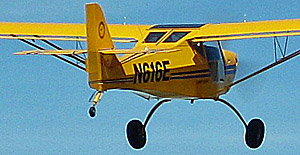 Summarizing then, aviation has three possibilities for taildraggers since the old tail skid: a tailwheel in fixed or locked position; the classic trailing, steerable tailwheel; and the new best choice: Beringer's no-trail innovation. With the latter, the pilot enjoys full movement while taxiing to the runway, sets the knob or lever (depending on how the kit builder or manufacturer implements this) to "lock" the tailwheel into limited steering for take off, and leaves it that way throughout landing. When ready to taxi back to parking, the pilot "unlocks" the tailwheel and again has broad steering control. Short of gross pilot error, Beringer's creation virtually eliminates the chance of the dreaded ground loop. Now pilots who grew up flying trigear airplanes can lose their fears and perhaps try a fun tailwheel aircraft design. Well done, Beringer!
Summarizing then, aviation has three possibilities for taildraggers since the old tail skid: a tailwheel in fixed or locked position; the classic trailing, steerable tailwheel; and the new best choice: Beringer's no-trail innovation. With the latter, the pilot enjoys full movement while taxiing to the runway, sets the knob or lever (depending on how the kit builder or manufacturer implements this) to "lock" the tailwheel into limited steering for take off, and leaves it that way throughout landing. When ready to taxi back to parking, the pilot "unlocks" the tailwheel and again has broad steering control. Short of gross pilot error, Beringer's creation virtually eliminates the chance of the dreaded ground loop. Now pilots who grew up flying trigear airplanes can lose their fears and perhaps try a fun tailwheel aircraft design. Well done, Beringer!